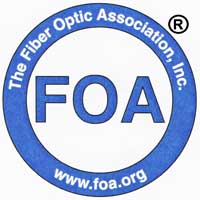

November 2023
|
Search the FOA website
FOA Home Page
Contact
Us
|
Sign
up for the FOA eMail Newsletter
Privacy Policy
Links To Sections
News
Technical
Worth
Reading Q&A
Training/FiberU
Resoures
Safety
About
|
Features
Training - Expense or Investment?
Canadian Contractor Trains Their Novices The FOA Way
Aerial Cable Plants "Hall of Shame"
Disaster Planning And Recovery
How Many Telecom Techs Do We Really Need?
How Big Is The Fiber Optic Market
Links To Resources On Broadband
Newsletter Sections
Click
on any link to jump to that section
News
Calix Created Online Training For Service Providers
FOA CFOS/D Design Curriculum In Spanish
Are Communications Satellites Harming The Atmosphere And Ozone Layer?
Google FIber Letter To Broadband Leaders
AT&T Fiber Price List
Cleveland To Build Open Source Network
CFOT Course In Spanish
Illegal To Sell Counterfeit Cables Online
Scouts Send Morse Code Over Fiber
POF Conference Comes To Ireland
Technical
New Product Month
FTTH Drop Cables
Learning From A Cable Scrap
Problems with Old and New Cables
Managing Projects - Gantt Charts
FOA Color Code Guides
FOA Online Loss Budget Calculator
Worth
Reading Lots of interesting
articles
Q&A
Questions from our readers
Always Interesting!
Training/FiberU
Types Of Work Done By Fiber Techs
FOA-Approved School News
Fiber U
MiniCourses
Resources
New FOA Technical Resources
Safety
About the FOA
FOA Certified Techs:
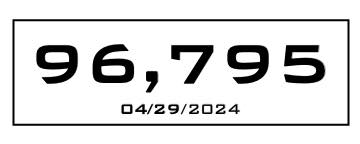
Time
To Renew Your FOA Certifications?
Special offer - 1/3
Off Renewal
Jobs
- See FOA Jobs
Web Page and FOA on

- The FOA Jobs
Web Page has been updated and a new page added
on Using your FOA
Training/Certification to Find the Right Job
in Fiber Optics
Where
Are The Jobs In Fiber Optics? FOA talks about
all the applications for fiber optics, what jobs
involve and the qualifications for the workers in
the field in this YouTube video.
Join The FOA eMail Newsletter
List
Want
to be notified when the FOA Newsletter is updated? Sign
up for the FOA eMail Newsletter. You can
also sign up from your cell phone: text "FOA" to
22828 (usual text message charges apply)
Trademarks:
The FOA CFOT® (Certified Fiber Optic Technician) and
Fiber U® (the FOA online learning site) are
registered trademarks of the FOA.

Want to know more about fiber optics?
Looking for specific information? Here's the largest
technical reference on the web: The
FOA Online Fiber Optic Reference Guide.
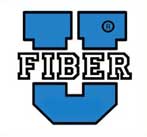
Free online self-study programs
on many fiber optics and cabling topics are
available at Fiber U,
FOA's online web-based training website.
FOA
Reference Books
Available Printed or eBooks
The fiber book is
available in Spanish and French
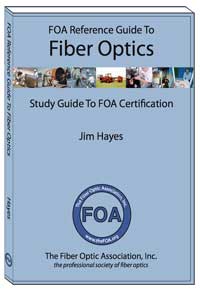 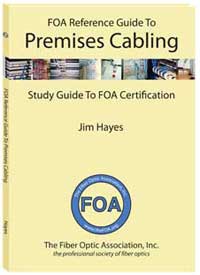 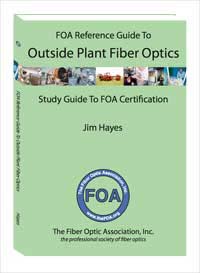
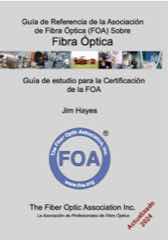
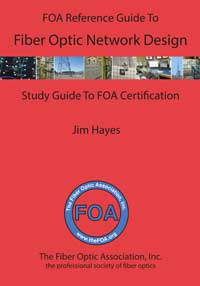 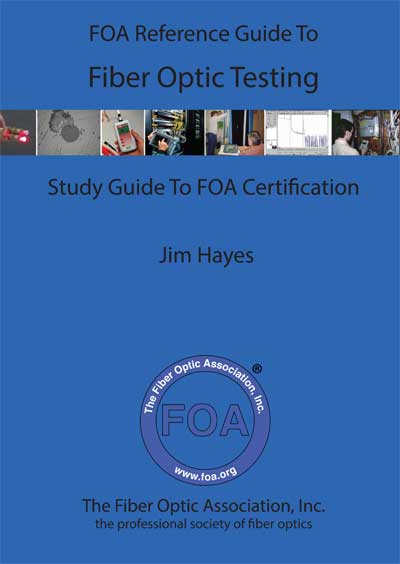
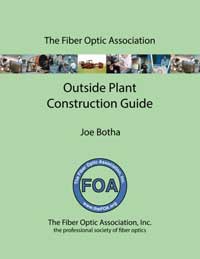 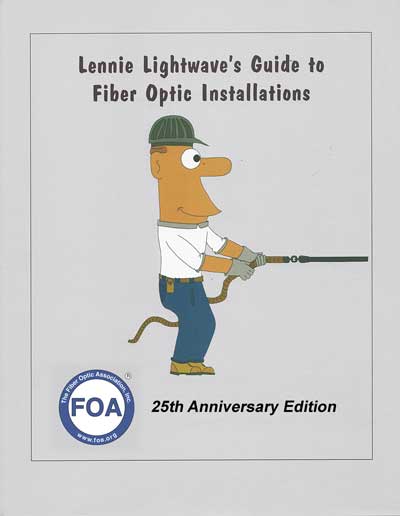
Lennie
and Uncle Ted's
Guides are now also available as free iBooks on
iTunes.
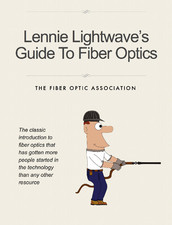
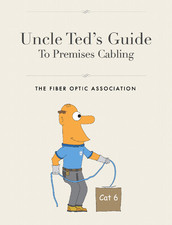
Click on any of
the books to learn more.
- Fiber
Optic Safety Poster to download and
print
FOA Videos on 
FOA
is a member of:




The FOA Newsletter is
edited by Jim Hayes - send your stories, leads,
ideas, comments to <jim @ foa.org>

Search the FOA Website With
DuckDuckGo
Top Stories From The Past FOA Newsletters
- The Archives: Past
Issues.
- Use these links to
read past issues or use FOA's
Custom Search to look for specific
topics on our website.
1/23, 2/23, 3/23, 4/23, 5/23, 6/23, 7/23, 8/23, 9/23, 10/23, 11/23,
1/22, 2/22, 3/22, 4/22, 5/22, 6/22, 7/22, 8/22, 9/22, 10/22, 11/22, 12/22
1/21, 2/21. 3/21, 4/21, 5/21, 6/21, 7/21, 8/21, 9/21, 10/21,
11-12/21,
1/20,
2/20,
3/20.
4/20,
5/20,
6/20,
7/20,
8/20,
9/20,
10/20,
11/20,
12/20,
1/19,
2/19,
3/19,
4/19, 5/19, 6/19, 7/19, 8/19, 9/19,
10/19,
11/19,
12/19
1/18,
2/18,
3/18, 4/18,
5/18, 6/18, 7/18, 8/18, 9/18, 10/18,
12/18.
1/17, 2/17, 3/17, 4/17, 5/17, 6/17,
7/17,
8/17,
9/17,
10/17, 11/17,
12/17
1/16, 2/16, 3/16,
4/16,
5/16,
6/16,
7-8/16,
9/16,
10/16,
11/16,
12/16
1/15,
2/15,
3/15,
4/15,
5/15,
6/15,
7/15,
8/15,
9/15 ,
10/15,
11/15
, 12/15
1/14,
2/14,
3/14,
4/14,
5/14,
6/14,
7/14,
8/14,
9/14,
10/14,
11/14,
12/14
1/13,
2/13,
3/13,
4/13,
5/13, 6/13,
7/13,
8/13,
9/13,
10/13,
11/13,
12/13
1/12
, 2/12,
3/12,
4/12,
6/12,
7/12,
8/12,
9/12,
10/12,
11/12,
12/12
1/11 ,
2/11,
3/11,
4/11,
6/11,
7/11,
8/11,
9/11, 10/11,
11/11,
12/11,
1/10 ,
2/10,
3/10,
4/10,
05/10,
07/10,
08/10,
09/10,
10/10,
11/10
1/09 ,
2/09,
3/09,
04/09,
05/09,
07/09,
08/09,
09/09,
10/09, 11/09,
12/09
1/08 , 2/08, 3/08, 4/08, 5/08, 6/08, 7/08, 8/08, 09/08, 10/08, 11/08, 12/08
12/07 , 11/07, 10/07, 09/07, 08/07, 07/07, 06/07, 05/07, 04/07, 03/07, 2/07, 1/07
12/06 , 11/06, 10/06, 09/06, 8/06, 7/06, 6/06, 5/06, 4/06, 3/06, 2/06, 1/06,
12/05 ,11/05, 10/05, 09/05, 08/05, 07/05, 6/05, 5/05, 4/05, 2/05, 01/05,
12/04 , 10/04, 9/04, 8/04, 7/04, 6/04, 5/04, 4/04, 3/04, 1/04,
12/03 , 11/03 10/03 9/03, 8/03, 7/03, 6/03, 3/03, 10/02 , 8/02, 5/02
Current Issue of FOA
Newsletter
New Fiber U Self Study Programs
Fiber Characterization (for long distance, high speed networks)
Minicourses: Attenuators, Reference Cables, Project Management Fiber Optic Jargon
December 2022 Special Feature: A Salute To FOA's Schools And Training Organizations
Time To Renew Your
FOA Certifications?
To
keep your FOA certifications active, you need to
renew them when they expire. Now we have a new more
convenient way to renew - an online store at Paypal
- where you can quickly and conveniently use your
PayPal account or your credit card to renew your
certifications.
- Renew
online with a credit card or PayPal
-
Join FOA On
Social Media

FOA
has 3 LinkedIn Groups
FOA
- official page on LinkedIn - covers FOA, technology and jobs in the fiber optic
marketplace
FOA
Fiber Optic Training - open to all, covers
fiber optic technology and training topics
Grupo
de La Asociación de Fibra Óptica FOA (Español)
|
Training - Expense or Investment?
The arguments against training usually center on cost. We hear:
"Training is expensive and after getting trained and certified workers
often leave my company for jobs paying more money" or "I can't afford
the time off the job - we're too busy now." When the economy slows,
training is the first cost to be cut.
The reason is understandable - cost is cost and sometimes cutting
cost is the primary focus of a business. But what gets forgotten is the
idea of "cost/benefit" or "cost/benefit ratio." The cost is easy to
understand; the benefit requires a bit more consideration. Better
trained workers are more efficient, producing better work in less time,
making the company more productive and that usually means more
profitable.
Well-trained techs also do better work because they are proud of
their accomplishments and take pride in their work. FOA has documented
the poor installation work we see overhead, like we're doing this month.
Trained techs don't leave work like that hanging overhead where
everybody can see the quality of the work. The workers should not be the
only ones blamed for such poor quality work - their bosses deserve some
of the blame as does the customer who accepted that job.
Want proof that training is an investment? Read on:
Canadian Contractor Trains Their Novices The FOA Way
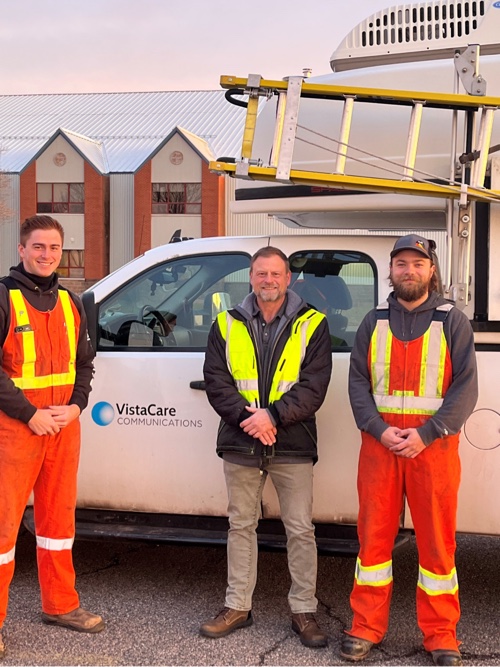
Calvin Hoeg, Byron Klefenz and Jacob Lang of VistaCare Communications, in Bedford, Nova Scotia, Canada.
VistaCare Communications
owners Byron Klefenz and Sean Reyno had a need to hire more people for
the jobs they had. The problem is there weren't a lot of skilled workers
available. To solve this problem, they hired Jane Bailey, CFOS/I, of FOTC, an experienced FOA certified instructor and master splicer with 24 years of field experience to join them and train new techs.
VistaCare and Jane developed a paid training program that encompasses
formal training and OJT. One week is devoted to the FOA CFOT curriculum,
then they are sent into the field for orientation and beginning OJT.
"The first training group was exciting to watch and mentor," said Jane
Bailey. The first project was a fiber run of 64km with 29 splice points
including midspans. They spliced, terminated racks did both OLTS and
OTDR testing. They found a splice point at 41.62km that required a redo
and an open fiber at 56.7km. After testing from both ends they
pinpointed the locations and fixed the problems.
The fellas built and spliced it and made a great show of getting the job
completed and creating an aesthetically pleasing network. As their
instructor and manager, Jane Bailey was impressed by the awesome job
done by her team.
FOTC.ca is an FOA approved school operating under VistaCare Communications in Bedford, Nova Scotia, Canada.
Think about that while you look at some of the workmanship seen in these jobs below.
Aerial Cable Plants "Hall of Shame"
The problem (?) with aerial cable plants is the workmanship is out in the open
where everyone can see it, which makes one wonder what installers are
thinking when they create such terrible messes overhead. Here are some
recent photos from just this month.
This example of lashing aerial cable (or not) was spotted in Kirkwood, MA by FOA instructor Milt Murry)
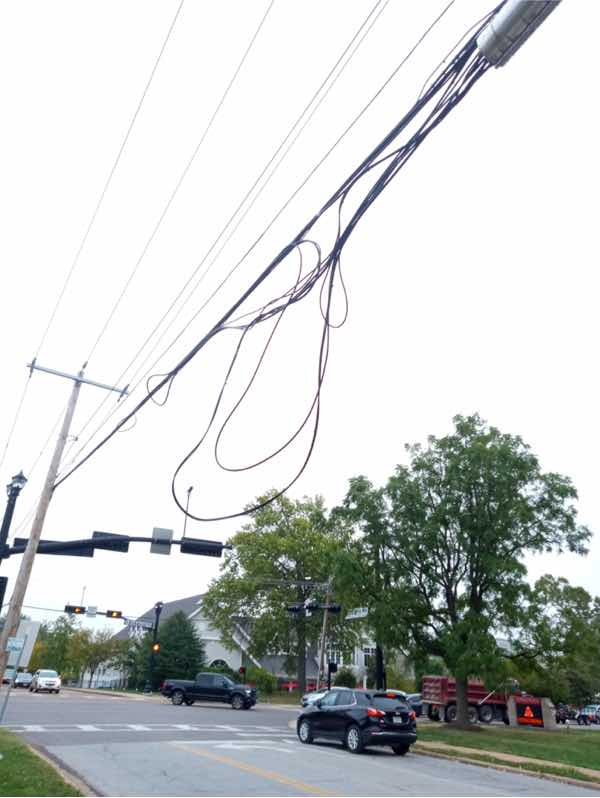
The two examples of creative mounting of splice
closures were spotted in the Atlanta, Georgia area by FOA founder and
instructor Eric Pearson
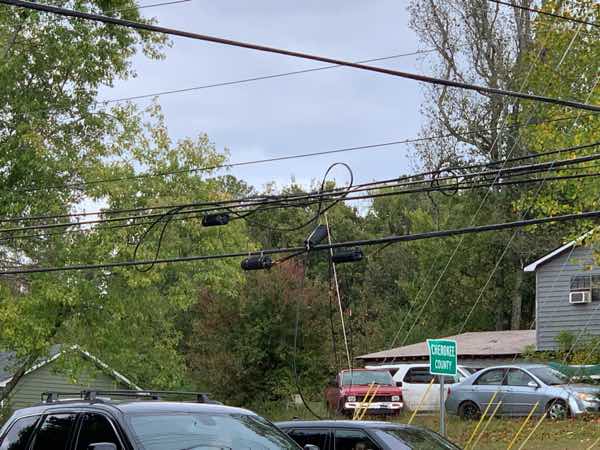
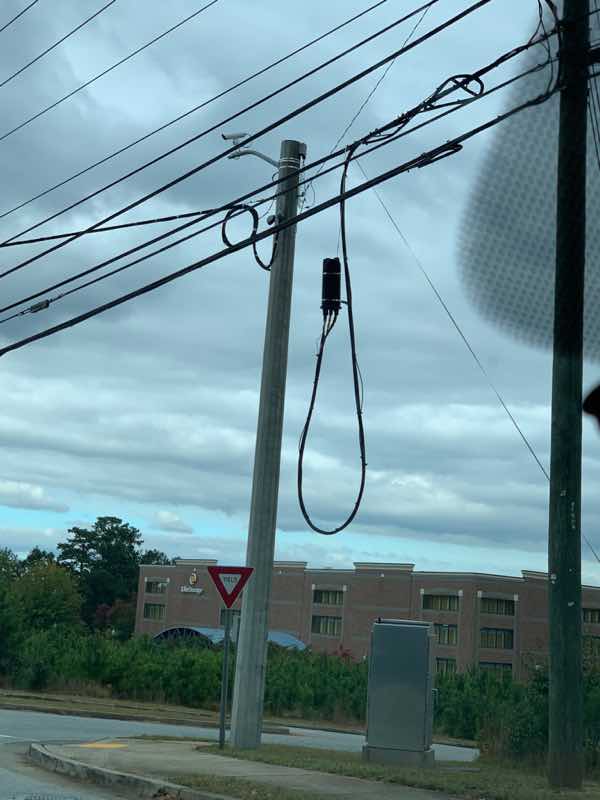
These two below are from Hollywood, CA (JH photos) Don't you like the use of the fence to hold service loops?
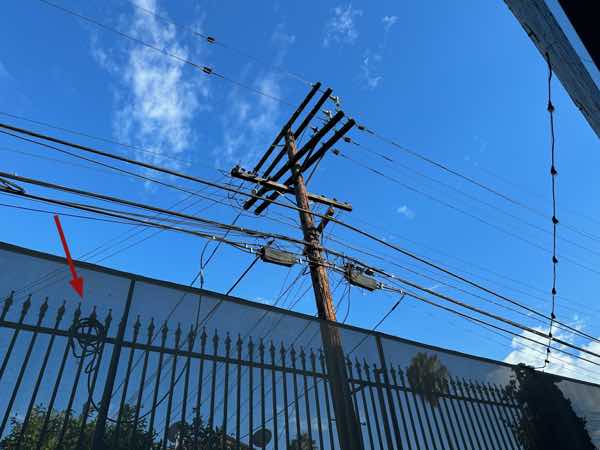
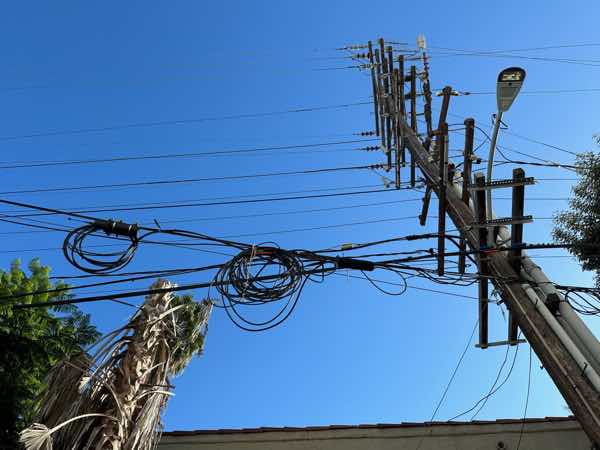
And one near LA Chinatown - it's not even connected, just hanging there.
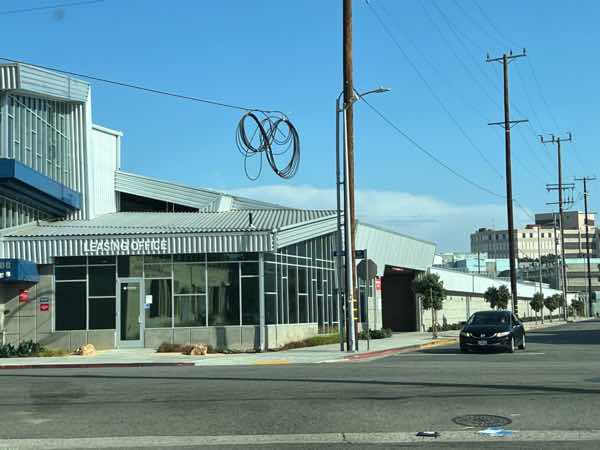
Question: Does any permitting authority require
identification labels on aerial cables so the owner and/or installer
can be identified?
And sometimes what you see below the cable son the
ground is awful also. ( from Bill Graham, FOA founder, retired, in the
Toronto area)
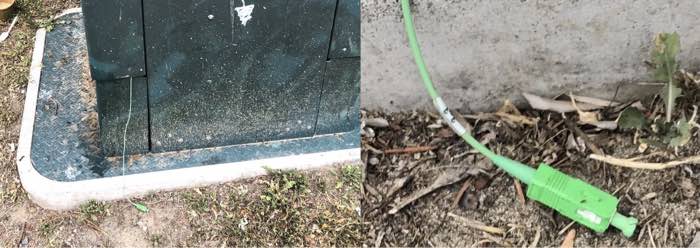
Would a trained, certified fiber optic tech leave installations like these visible for all to see?
Disaster Planning And Recovery
FOA has been documenting the issues with
communications networks caused by natural disasters, something that has
been in the news a lot recently. The graph below from Next Century
Cities shows why.
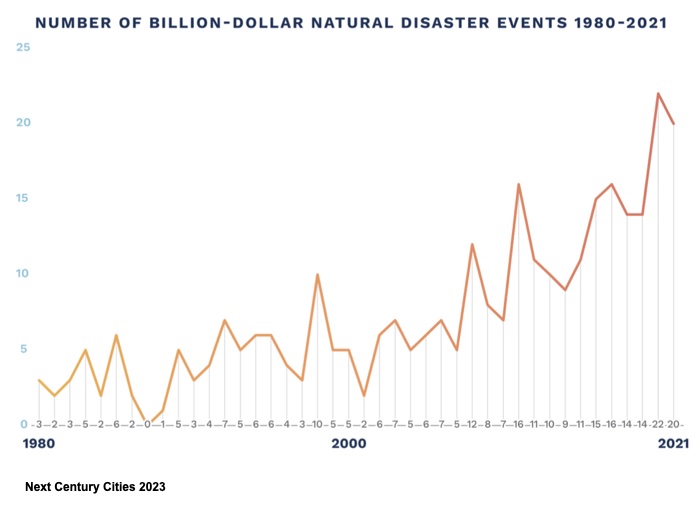
This graph comes from a new publication from Next Century Cities (NCC) called Wildfires, Natural Disasters, and Network Resilience that discusses disaster preparedness.
"States and localities are not the only ones that
should take proactive planning measures to ensure new and existing
telecommunications and broadband networks are resilient. Providers and
other network operators should upgrade equipment or ensure that proper
backups are in place to mitigate future outages before a disaster
strikes a community."
NCC has 3 major suggestions:
1. Providers Should Replace Aging or Outdated Network Infrastructure.
2. Collaborating with State and Local Governments Helps Providers Address Regional Nuances.
3. Federal lawmakers and the Federal Communications
Commission should promote information sharing and develop benchmarks for
resilience planning.
But the notion that private service providers
cooperate with government is naive. That relationship has been
contentious forever; private companies spend millions on lobbying to
prevent government regulation like regulating the Internet as a common
carrier, network neutrality or providing proper coverage in underserved
areas (hence the $43.5 billion BEAD program.)
Furthermore, planning has to start considering the
effects of a changing climate. We are seeing disasters that are being
called "once in a century" events every year or two. Not only is
California suffering from unprecedented numbers of wildfires (Canada and
Europe also) but California has been the scene of disastrous flooding
last year and more predicted for the coming year. Remember when all
anyone worried about in California was earthquakes?
The nature of the disasters can also be different.
NY Transit Authority, a FOA approved training organization, said that
Hurricane Sandy flooded facilities with salt water which has corrosive
properties that were never considered and some of the infrastructure is
unsalvagable. Coastal cities need to worry about that as more storms
coupled with rising seas flood these cities with salt water.
Consider this headline and photo below from the Washington Post: Otis dissipates after cutting communication to Acapulco as Category 5 hurricane

What kind of communication network has been planned
to survive a Category 5 hurricane, flooding, muddlides or intense
wildfires? What communications service provider will invest in building a
network that can survive such a disaster?
Also worth reading: Wildfires, Natural Disasters & Network Resilience by Next Century Cities
We received this
invitation recently to a short webinar on disaster management focusing
on communications - planning, responding and recovering.
Disaster Management Symposium
IWCE’s Urgent Communications and American City &
County will host the Disaster Management Symposium, a virtual forum
November 8 from 10 a.m. to 1 p.m. PT. Join them for three sessions
focused on how to plan, respond, and recover from a disaster according
to industry experts.
More information and registration.
How Many Telecom Techs Do We Really Need?
In the newsletter this month from BBC (Broadband Communities) a industry spokesperson was quoted as saying. " the country will need 205,000 fiber-optic technicians to meet
the demand created by the BEAD program."
205,000? That's a lot! How did they come up with that number.
Let’s
look at this logically. The BEAD program is for $43.5billion, It covers about 10
million unserved or underserved households which will be mostly FTTH, built out over 5 or
more years. That's about 2 million homes per year.
According to reports on the FTTH market, the current workers did 8
million FTTH connections last year, but in addition they built hundreds of data centers,
thousands of miles of backbone (hundreds of thousands?), and thousands
of other fiber optic jobs for security, electrical grid, transportation, etc.
Now
we have the DoL Bureau of Labor Statistics documenting the telecom workforce, they say we have 300,000
telecom techs, of which 15,000 are wireless tower techs and 112,000 are fiber
installation techs. The rest are equipment techs or operational
personnel.
So somebody thinks we need 205,000 fiber techs just to connect another 2
million homes a year on fiber? Let’s see - 2 million homes
installed by 205,000 more techs is about 10 homes each…. per year...?
Did they add a zero to the end of that number by mistake?
Here's what FOA said last month:
There is no question we need more fiber techs but
it's not because of BEAD. Like all trades, the workforce is aging and
older workers retiring outnumber new recruits. Some surveys have shown
that recruits to some trades are only about 20% as many as are needed to
replace those leaving.
Read the rest of the article in the October 2023 FOA Newsletter.
How Big Is The Fiber Optic Market?
The fiber optic market in the US has been wildly excited about the
BEAD program, $43.5 billion for broadband in unserved and underserved
areas. As we have analyzed before (FOA Newsletter July 2023), this
funding will be spent connecting something more than 10 million users
over at least 5 years. That's a about $4 billion per year.
In last month's FOA Newsletter
we analyzed the current FTTH market. If the FBA's numbers are correct,
the 8 million new FTTH connections last year created a market of about
$8 billion in a year. That's about what the BEAD program will cost per
year once it gets going, but it will represent only about 1/4 as many
connections due to its focus on under- and unserved areas like rural,
small towns and unserved cities.
Now $8 billion is a lot of money, but how much of the fiber optic
market does it represent? Other than a few very large public projects
like the California Middle Mile project that will cost more than $3
billion over a few years, it's impossible to tally up the value of all
the thousands of projects in the US, not to mention the rest of the
world.
There are other ways to estimate markets.
For example, in the last
month we've received several emails from market research companies
offering reports on the worldwide fiber optic cable market. These
reports quoting estimates that fiber optic cable is a $5-12 billion/year
market worldwide raise the question of where those numbers come from
and how reliable they are.
But that's just fiber and cable. What about other
hardware and tools? Fusion splicers and OTDRs are expensive tools with
many manufacturers. How do we include construction costs with fiber
optics? Ducts, poles, cabinets, splice closures, communications
equipment, etc. that are used in enormous volumes. The biggest cost in
construction might be labor - how do we include that? And of course how
do we factor in the regional cost differences?
You just make an educated guess. For projects we can get data about, we
estimate the fiber optic cable represents ~5-10% of the cost of a
project. That would make the worldwide network market somewhere between
$50 and $240 billion per year. That's just the cable plant - no
communications equipment attached to it - which would probably more than
double that number.
To put this in perspective, the annual expenditures deploying wireless worldwide is estimated to be $85 billion to $95 billion. If you like overviews of that market the Deloitte 2023 Telecom Industry Outlook is very interesting reading. And capital expenditures (CAPEX) for major US service providers is around $60 billion per year (Fierce Telecom) which includes
So the ~$8 billion in BEAD money per year is a lot of money but represents a small part of the overall fiber optic marketplace.
Latest FOA Book: Fiber Broadband Is A Hit With Broadband Planners
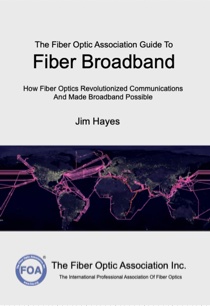 How does broadband work? Without fiber optics it would not work; even wireless has a fiber backbone.
This book is not the typical FOA technical textbook - it is written for
anyone who wants to understand fiber broadband or fiber optics or the
Internet. It's also aimed at STEM teachers who want to include
communications technology in their classes. This book will try to
explain not only how fiber broadband works, but how
it was developed. It is intended to be an introduction to
communications technology
appropriate for a communications course at almost any level (junior
high, high school or
college,) for managers involved with broadband projects, or for anyone
who just wonders how all this stuff works. How does broadband work? Without fiber optics it would not work; even wireless has a fiber backbone.
This book is not the typical FOA technical textbook - it is written for
anyone who wants to understand fiber broadband or fiber optics or the
Internet. It's also aimed at STEM teachers who want to include
communications technology in their classes. This book will try to
explain not only how fiber broadband works, but how
it was developed. It is intended to be an introduction to
communications technology
appropriate for a communications course at almost any level (junior
high, high school or
college,) for managers involved with broadband projects, or for anyone
who just wonders how all this stuff works.
The Fiber Optic Association Guide To Fiber Broadband Paperback ($12.95) and Kindle ($9.95) versions available from Amazon or most booksellers. Kindle version is in color!
Cross Reference Guide to Textbooks, Online Guide and Fiber U FOA Videos Guide.
FOA has a web page with resources on fiber broadband and the IIJA/BEAD funding programs.
FOA Newsletter
Sections
News
Technical
Worth
Reading Q&A
Training/FiberU
Resoures
Safety About
|
|
News
Lots more news
in Worth Reading below
|
Calix Creates Online Training For Service Providers
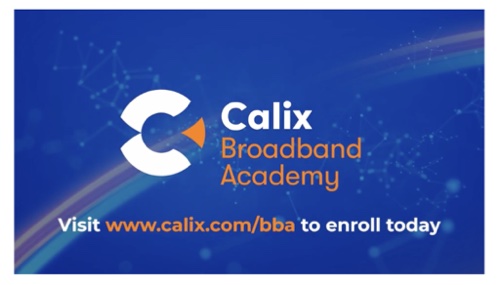
FOA has always been focused on the cable plant and
its design, installation and operation, but the equipment that
communicates over that cable plant is also very important. Calix is one
of the major providers of broadband communications equipment and they
understand the importance of training also. They have created the online
"Calix Broadband Academy"
to educate broadband service providers about the five stages of
building a successful broadband business. The five stages include the
three FOA focuses on, design, installation and operation, but adds two
critical areas faced by a broadband ISP running a business, funding the
operation and marketing to the customers.
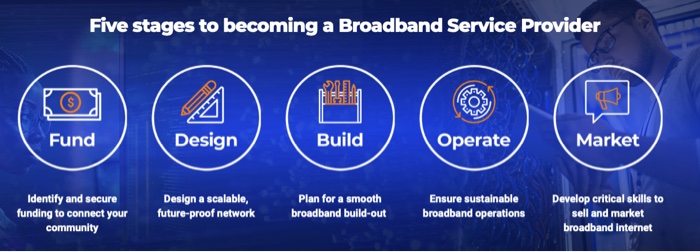
Calix has created a Broadband Academy eBook
that covers the same material in a format that ie easy to share among
others in the agencies working on developing a broadband program.
And they hold the ConneXions conference annually and more virtually for service providers.
At the Calix ConneXions 2023 conference
this fall, FOA provided copies of the FOA book on Fiber Broadband to
hand out to attendees at a "Train The Trainer" session where broadband
leaders learned how they can deliver meaningful and fun broadband
education to their communities.
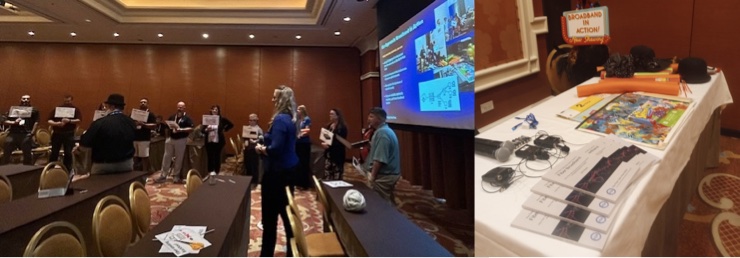
At the Calix ConneXion Confrence, attendees were given copies of the new FOA Guide To Fiber Broadband
At this session Calix announced FOA's Fiber U as their "Install and Repair" curriculum of choice for Calix customers
More on Calix Broadband Academy , the next virtual ConneXions conference Nov 7-9, 2023 and Calix Connections 2024 conference.
FOA Curriculum For Schools Adds Fiber Optic Network Design in Spanish
FOA is an international organization so we have
expanded our website, textbooks and training curriculum to other
languages, with Spanish being the most popular. We have recently
translated the curriculum for CFOS/D Fiber Optic Network Design into
Spanish for our schools in Spain and the Latin and South American
countries. We also have schools teaching in Spanish in the US as you can
read below.
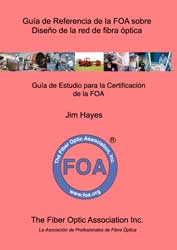 The FOA Design textbook is available in Spanish also. The FOA Design textbook is available in Spanish also.
The FOA CFOS/D curriculum in Spanish includes the necessary materials
for an instructor to present the course in Spanish and give the cfoS/D
certification exam in Spanish. The material is available to any
FOA-approved school. For more infirmation on becoming a FOA approved
school, go here.
Quote Of The Month:
(last month actually, but this is worth repeating)
Speaking at the Goldman Sachs Communacopia +
Technology Conference today, AT&T’s CEO John Stankey said, “There’s a
fallacy to say there’s fixed networks and wireless networks. There are
only fiber networks with different access technologies on the end of
them. That’s where this is all going.”
Fierce Wireless
Are Communications Satellites Harming The Atmosphere And Ozone Layer?

Space-X Falcon 9 Rocket Launch (Space-X from Futurity)
We'ver had several articles in the FOA Newsletter before about the
massive numbers of low earth orbit (LEO) satelites being launched to
create a worldwide network for communications. We've also covered how
tens of thousands of these satellites are disrupting ground based
astronomy, but now research being done by NASA and Purdue University is
questioning the environmental impact of so many rocket launches and
thousands of satellites burning up in the atmosphere on reentry.
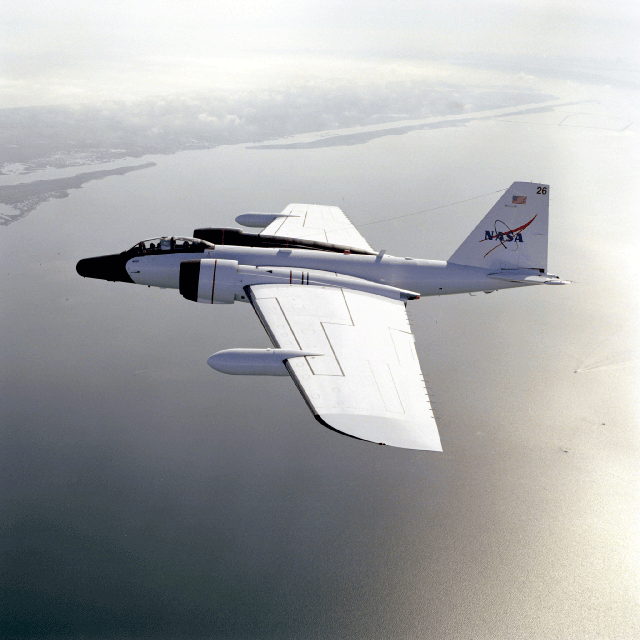
NASA RB-57 used in the high altitude research program (NASA)
Rockets leave behind them a trail of pollution including metals that may
change the atmosphere in ways scientists don’t yet understand.
Scientists have long suspected that spacecraft and satellites were
changing the upper atmosphere, but studying the stratosphere, where even
the highest flights enter only briefly, is challenging.
Using tools hitched to the nose cone of their research aircraft and
sampling more than 11 miles (17.7 km) above the planet’s surface,
researchers have discovered significant amounts of metals in aerosols in
the atmosphere, likely from increasingly frequent launches and returns
of spacecraft and satellites. That mass of metal is changing atmospheric
chemistry in ways that may affect Earth’s atmosphere and ozone layer.
“We are finding this human-made material in what we consider a pristine
area of the atmosphere,” says Dan Cziczo, one of a team of scientists
who published a study on these results in the Proceedings of the
National Academy of Sciences. “And if something is changing in the
stratosphere—this stable region of the atmosphere—that deserves a closer
look.” Cziczo is professor and head of the department of earth,
atmospheric, and planetary sciences at Purdue University.
“Just to get things into orbit, you need all this fuel and a huge body
to support the payload,” Cziczo says. “There are so many rockets going
up and coming back and so many satellites falling back through the
atmosphere that it’s starting to show up in the stratosphere as these
aerosol particles.”
The stratosphere is also the realm of the ozone layer: that gaseous
marvel that acts as a global tent to shield the planet and all life on
it from the searing, scorching rays of ultraviolet radiation. Without
the ozone layer, life would likely never have arisen on Earth. And
without it, life is unlikely to be able to continue.
Scientists estimate that as many as 50,000 more satellites may reach
orbit by 2030. The team calculates that means that, in the next few
decades, up to half of stratospheric sulfuric acid particles would
contain metals from reentry. What effect that could have on the
atmosphere, the ozone layer and life on Earth is yet to be understood.
Will environmental concerns affect the deployment of LEO satellites,
favoring the geostationary satellites like VIASAT and Hughes?
Read more at Futurity.
Google Fiber's Open Letter to State Broadband Leaders on Planning for BEAD and Future Deployment Efforts
Google Fiber has written an open letter to broadband
leaders about their recommendations for planning the deployment of
broadband networks. It's interesting reading, If you have followed the
history of Google Fiber, you can recognize points they make that are
lessons they learned, often the hard way. You can read the letter on the website of the Benton Institute for Broadband & Society. We summarize the points they make here.
The following six recommendations answer a straightforward
question: What can state broadband leaders do right now to remove
barriers for broadband deployment? We hope you will find these
suggestions helpful as you continue to expand broadband access across
your state.
1. Work with State 811 One Call Center to Address Locates Constraints
2. Streamline Permitting: Create Standardized Resources for Cities and Counties to Simplify the Permitting Process
3. Promote Broadband Choice and Competition for Multifamily Property Residents
4. Assign a Designated State Official to Liaise with Cities on Broadband Build-Out
5. Create and Promote a State and Local Government “Broadband
Innovation Resource List” to Keep Cities and Counties Up to Date on the
Latest Technological Developments
6. Set up a State-County-City Task Force that Meets Regularly to Share Information and Troubleshoot Issues
Final Thoughts
To close the digital divide, we need close partnership among
state broadband leaders, local governments, and broadband deployers.
With historic investment in broadband deployment, partnerships will help
meet immediate connectivity and affordability needs. But our goals are
aligned – bring connectivity to as many households as possible, and as
quickly as possible.
What's Next For Google Fiber? Interesting reading from the Google Fiber blog.
Straight From the FOA Email Inbox (Without Comment)
AT&T Dedicated Internet with a customer managed router- Monthly costs-
10MBX10MB- $448.24
20MBX20MB- $491.84
50MBX50MB- $580.91
100MBX100MB- $786.00
150MBX150MB- $808.00
250X250MB - $989.60
400X400MB- $1127.80
500X500MB-$1184.50
600X600MB- $1312.20
1GBX1GB- $1540.60
Cleveland, the "Worst Connected City," To Build Own City-Wide Open Access Fiber Network
Do-it-yourself open access fiber networks continue to gain acceptance.
Cleveland, Ohio, USA is putting the finishing touches on an ambitious
plan to build a citywide open access fiber network–and deliver
affordable fixed wireless service–at minimal cost to city residents. The
double-edged proposal aims to bring both meaningful broadband
competition–and lower rates–to the long neglected city of 1.7 million
people.
Last month, the city announced it had awarded $20 million in ARPA
(American Rescue Plan Act) funds to Cleveland-based digital equity
non-profit DigitalC. Under the proposal, DigitalC will spend 18 months
building a fixed wireless broadband network capable of providing locals
with symmetrical 100 Megabit per second (Mbps) service for $18 a month.
In addition to the partnership with DigitalC, Cleveland city leaders
passed an ordinance in late September to encourage investment from a
private New Jersey-based telecom provider, SiFi Networks. As part of
this arrangement, SiFi will spend 7 years building a $500 million
citywide open access fiber network at no cost to taxpayers, paid off by
leasing access to the network to other ISPs.
Read more at ILSR.
UPDATE: FOA CFOT Course For The Spanish-Speaking Community in Raleigh, NC
Wake Tech Community College in Raleigh, NC offered a
special FOA CFOT course recently for the local Spanish-speaking
community. The course was taught by their instructor, Gilberto Guitarte
who is from Argentina, using the FOA CFOT course curriculum which is
available in Spanish. The highlight of the course (beyond the fact that
all students passed with flying colors) was that student Yamilet from
Cuba was expecting baby
Isabela probably during the course.. Partner Oscar (also a student
originally from
Cuba) is standing by her side holding hands in the picture.
Yamulet and Oscar are now parents as well as trained fiber techs. Baby
Isabella was born while the parents were still in training (as fiber
techs!) Training as parents will take decades!
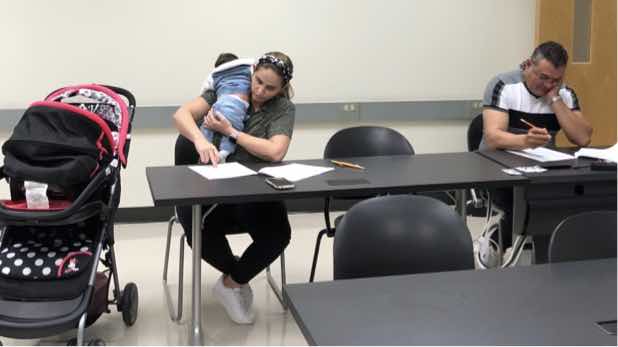
Gilberto tells us he wonders if Yamulet's excellent score on the CFOT test was due to some help from baby Isabella!
It's Finally Illegal To Sell Counterfeit Cables (And Anything Else) Online
FOA has been reporting about counterfeit cable,
mostly "Cat 5" UTP, since 2011* we first showed photos we took of fake
Cat 5 made with copper-clad aluminum wires instead of solid copper
wires. We've taken photos of the counterfeit cable and even did a video showing how it could not meet UL specs due to the way it burned.
Eventually UL responded (the counterfeiters learned to make fake UL
holographic labels) as did some cabling organizations, but that has not
stopped the sale of these products online.
Finally the US Federal Trade Commission has a law to use to prosecute
these online fakes. Congress passed the Integrity, Notification, and
Fairness in Online Retail Marketplaces for Consumers Act – or the INFORM
Consumers Act – effective as of June 27, 2023. The Federal Trade
Commission and the States have authority to enforce the new statute and
online marketplaces that run afoul of the law could be subject to steep
financial penalties. Violations could result in civil penalties of
$50,120 per violation for online marketplaces.
Read more on the FTC website.
* Contractors Discovers Why "Cat 5E" Cable Has Problems - It's Not Copper!, FOA Newsletter, March 2011.
Infrastructure Resources Is Now "Excavation Safety Alliance" - Join Now
Infrastructure Resources has changed its name to Excavation Safety
Alliance (ESA) to better reflect their role in the industry. ESA
believes that a focus on safe excavation education initiatives helps
prevent damage to buried facilities. Focusing on safe excavation
spotlights the importance of safety for the people doing the digging,
and helping keep people safe is the top priority of both damage
prevention and safe excavation efforts.

Join The Excavation Safety Alliance
The
are now over 1,500 individual members of the Excavation Safety
Alliance. The individual memberships are FREE because we want everyone
to have a voice and the ability to get the valuable education.
Individual membership is free; corporate membership is $2000.. For more information, go here.
ESA sponsors the annual Global Excavation Safety Conference which will be held in New Orleans in 2024.

Global Excavation Safety Conference will be held in the city of New
Orleans, Louisiana, from March 19-21, 2024. This is an opportunity for
damage prevention & excavation safety professionals from all over
the world to come together and learn, network, and share their knowledge
and expertise in this vitally important field.
More info on Global ESC 2024
|
Technical
Fiber optic
technology, standards, equipment, installation,
etc.
The FOA
Update Page covers the new technology
and applications we covered in this newsletter
recently. Now you can review all that new tech at
once.

Cross Reference To FOA Technical Reference Materials
The FOA has almost 1,000 pages of technical information on the FOA Guide,
100+ videos and two dozen online courses at Fiber U, all this can make
it difficult to find the right information.
Cross Reference To FOA Tech Materials
To help this, we have created a cross reference guide to the textbooks,
Online Guide and Fiber U courses, all the FOA technical information.
Besides the textbooks, online Guide and Fiber U, each section of the
Guide also includes links to the 100+ FOA videos available.
Cross Reference Guide to Textbooks, Online Guide and Fiber U
FOA Videos
We have also rearranged the 100+ FOA videos in similar categories on the
Contents Page of the Online Guide, making the videos, especially the
lectures, much it much easier to find a video on a particular
topic.
FOA Videos Guide.

Want to know more about fiber optics? Study
for FOA certifications? Free
Self-Study Programs are on Fiber
U®
|
 OptConn
is a value-add re-seller of optical connectivity products, services and
solutions. With over 30 years of experience in the fiber optics
industry we are here to serve your requirements from fiber optic
training with FOA certification to products, materials and supplies. OptConn
is a value-add re-seller of optical connectivity products, services and
solutions. With over 30 years of experience in the fiber optics
industry we are here to serve your requirements from fiber optic
training with FOA certification to products, materials and supplies.
We have partnerships with industry leading
manufacturers to support your installation, splicing and testing needs.
Our goal is to guide, support and recognized our client’s requirements.
Learn more about OptConn
|
New Products
New Fiber Splicer Kit Prepares Two Fibers At Once

The new AFL Fujikura 45S
splicer has a very useful new feature. It includes a new fiber stripper
that can strip 2 250 micron buffered fibers at once and an adapter
plate that allows cleaving two fibers at once. The two fibers, with one
in each hand, can even be placed in the splicer clamps simultaneously.
That should prove to be a real time-saver for the splicing tech.
250 > 200 > 180 > 160 Microns - Fiber Buffer Diameter Keeps Shrinking
In the race to make smaller cables with more fibers,
STL has introduced cables with fibers coated at 160 microns diameter.
STL claims that this fiber size allows 3 times as many fibers in a cable
as 250 micron fiber. The fiber is G.657 since reducing the buffer
diameter so much means the fiber needs to be bend insensitive fibers.
First use of the fiber will be in the company's home, India. Reported in Lightwave.
Klein Improves J-Hook Design
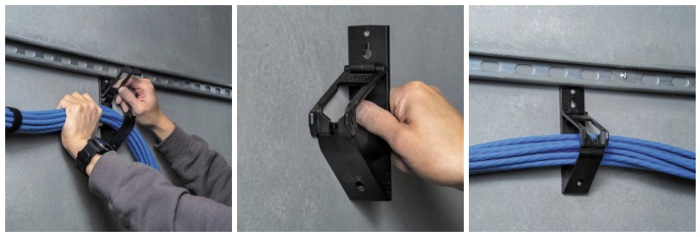
Improve the J-hook? Klein has done just that. The Klein J-Hook
is a unique 2-Piece latchable system that fully encloses cables. It has
a lockable latch easily opens to add or remove cables. Rounded edges
are designed to avoid damage to cable jackets. It has a 2-Point screw
hole mounting for permanent, secure mounting (screws included) and a
screw key slot for removable mounting.
VFL Demonstrates Fiber Scattering And Provides Hypnotic Entertainment
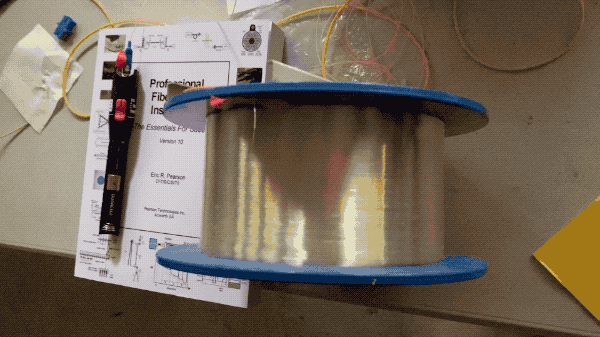
Courtesy of Eric Pearson, Pearson Technologies (Eric is FOA School #101, the first FOA approved training organization!)
Innovative Connector Cleaning Dust Cap
It's a common joke in fiber optics - the plastic
covers over the ends of connectors are called dust caps because they can
be a major source of dust contamination on connector ferrules. These
plastic covers are molded in the millions and dumped into giant bins
with no thought of keeping them clean, so they often contain dust and
mold release fluid. When they are slipped over the end of a connector
ferrule, even a clean one, they may leave dust and contamination on the
ferrule. So the smart installer cleans ever connector, even a new one.
But Clearfield, the supplier of many types of fiber hardware and an FOA
Approved training organization, has come up with a unique solution, a
dust cap with built in cleaner.
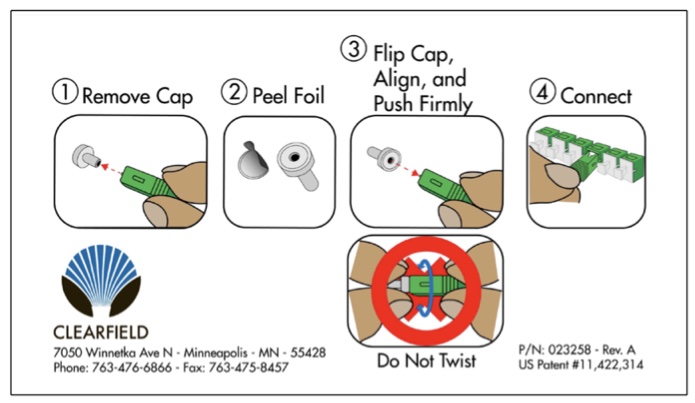
Clearfield says their ClearPass Dust Cap is more
effective than other field cleaning systems including cassette and card
cleaners. At this time it's available for all 2.5mm ferrule connectors.
Read the Clearfield data sheet here. Watch the video here.
Insider Info
From a reliable source within the industry: Within a couple of years, the old inflexible
hard ribbon cables will be extinct. Everything will be flexible ribbons
and mostly 200 micron fibers and BI (bend insensitive) fibers (G.657). Besides
changing how these cables are handled, one thing will be lost - the
ability to print ID info on the ribbons so matching fibers to splice
will be more difficult.
Drop Cables For Customer Premises FTTH Installation
The last
optical segment of the FTTH cable plant is the drop segment. The drop
optical cable is located between the optical access point and ONT. The
optical access point is usually an optical splitter in the optical
distribution box. At this point, the drop cable must be connected to the
distribution network with fusion/mechanical splice or optical
connectors. On the other side, near customers, there is ONT, which
requires only an optical connector.
In this tutorial on drop cables, Vladimir Grozdanovic continues his
tutorials on FTTH cabling with a comprehensive article on FTTH drop
cables and how they are installed.
Vladimir Grozdanovic is a graduate electrical engineer for
telecommunications with more than 10 years of experience in access
networks (HFC and FTTH) in large cable operators in Serbia (SBB and
Jotel).
Read the article here.
Learning Important Information From A Found Cable Scrap
While walking down the street near the FOA office, we found this cable
laying in the gutter. What a find! A short length of Corning Rocket
Ribbon 864 fiber cable left over from an installation by a contractor.

We brought the cable back to our office with the intention of opening it
up and creating a video about the construction of this modern high
fiber count cable, but something got our attention first. The cable had a
very
long line of printing on it with lots of interesting and useful
information. So before we started deconstructing it, we decided to
photograph the printed information and interpret it. That turned out to
be an important part of the information we learned from the cable. Then,
as you will see below, we dissected the cable and learned even more.
Red more about what this cable marking tells you and what the cable looks like when you open it up to prepare for splicing.
Problems With Old Cables And New High Fiber Count Cables?
A FOA CFOT reported that they have been doing fiber characterization
testing on cable plants that include both old and new fibers, a common
result from building out from a legacy cable plant. One surprising
result was that some relatively short links are showing CD and PMD
problems even when only short segments of the cable plant are older
fibers. PMD has become an issue as speeds increase but earlier fibers we
not optimized to prevent PMD. This is just another reason to do fiber
characterization before trying to upgrade network speeds. (There is more
information on Fiber Characterization in the FOA Guide and a fiber characterization course on Fiber U.
We're also hearing rumors that the new high fiber
cables are getting fibers broken
during installation with the possible cause(s) being exceeding bend
radius or pulling tension, using improper installation equipment or
maybe even the cable designs. We're investigating this and will report
back in the near future. But please ensure installers follow
manufacturer's recommendations carefully. Check out the information on
cable specs in the article in this issue and the article on Bending Diameter in the FOA Guide.
Managing Fiber Optic Projects - The Gantt Chart
(With An Excel File To Make Your Own)
The most common way to track projects is the Gantt Chart, a
chart of activities that tracks the progress of projects along a
timeline. each activity is represented by a bar and the position and
length of the bar represents the starting date and duration of the
activity. This allows you to see what activities are needed for the
project, when the activities start and end so it can be used to track
the progress of the project visually. Here is what a Gantt Chart for a
fiber project might look like:
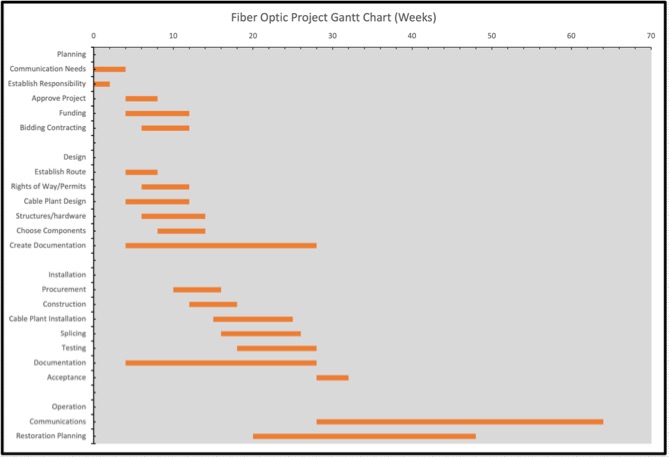
You might remember an article in the FOA Newsletter in April 2022 or the FOA Guide page on Project Management about the timing of a fiber optic project where we showed the progression of steps in a project like this:
The Gantt Chart above is simply this list converted to a Gantt Chart
using a Microsoft Excel spreadsheet. You can download a copy of the FOA Gantt Chart spreadsheet (xlsx file - 16kB)
and use it to create your own Gantt Chart for any project. All you have
to do is to input your own data and change the activity names as
necessary. You can also follow the directions from Microsoft to create your own version.
More Help On Color Codes (Including Copper Cabling And Fiber Optics)
The FOA has created a print-your-own pocket guide to fiber
optic color codes. It has
color codes for fibers and buffer tubes, connectors and premises cables
inside and on the back, QR codes to take you directly to the FOA Guide
and Fiber U. The FOA
Guide page on Fiber Optic Color Codes is one of the most read pages on the FOA
website and the Fiber Optic Color Codes minicourse on Fiber U very popular also.
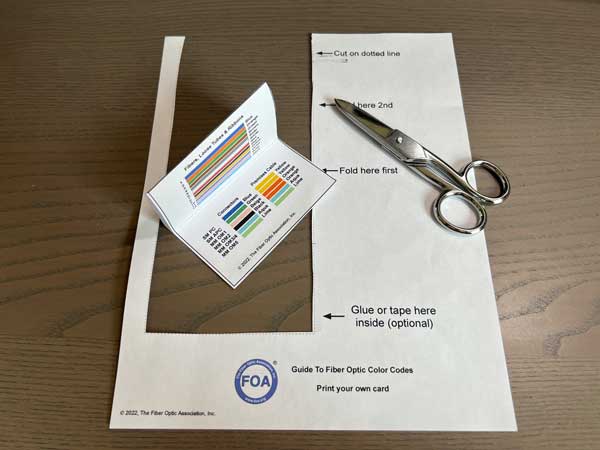 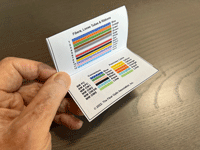 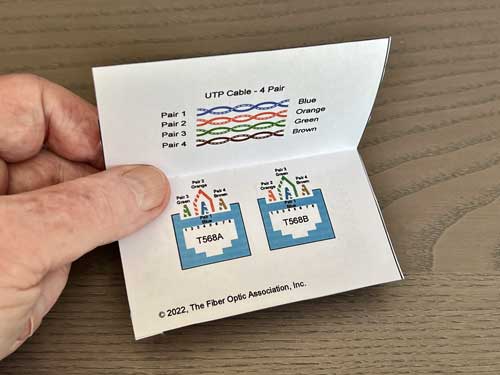
Here's a do-it-yourself FOA Guide To Fiber Optic Color Codes card.
Just download the PDF file, print it on a color printer and fold it up
as shown. Then you have your own pocket guide to color codes. Make a
bunch for your co-workers too.
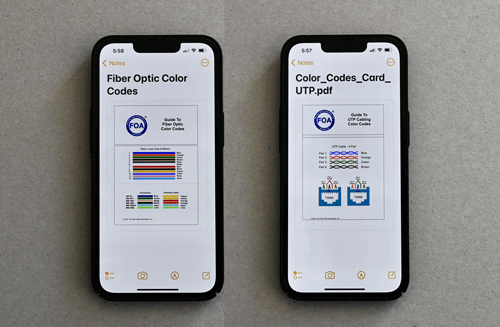 Then we realized that many of your also do structured cabling
work, so it was a natural to add a Color Code Guide for UTP copper
cabling in printable (below) and electronic (above) versions. Then we realized that many of your also do structured cabling
work, so it was a natural to add a Color Code Guide for UTP copper
cabling in printable (below) and electronic (above) versions.
But we did not stop there. We know how many of you use your mobile devices on the job, so we created a version of the Color Code Guide you could download
and use on your smartphone or tablet. It's a PDF file, so you just
download it and save it on your device and it will be with you always.
Here are the links to download your own FOA Guides to Fiber Optic Color Codes
FOA Guide to Fiber Optic Color Codes (print your own version) PDF
FOA Guide to Fiber Optic Color Codes (electronic version for your smartphone, tablet or PC) PDF
And For UTP Cabling
FOA Guide to UTP Cabling Color Codes (print your own version) PDF
FOA Guide to UTP Copper Cabling Color Codes (electronic version) PDF
Warning For Techs Doing OSP Restoration
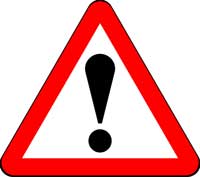
FOA received an inquiry about whether techs
working on restoring OSP links should be concerned about eye safety if
the link used fiber amplifiers. To answer this question, we had to do some research on fiber amplifiers.
The short answer is YES, you should be concerned. The long answer is
more technical and includes details that every OSP tech needs to know.
See "Fiber Amps And Restoration" in the FOA Newsletter Archives..
Try The FOA's Online
Loss Budget Calculator
FOA
has written many articles about loss budgets,
something everyone involved in fiber optics needs to
know and needs to know how to calculate. We've
created a online Loss Budget Calculator that does
the work for you. Just input your cable plant data
and it calculates the loss budget. It works on any
device, especially smartphones and tablets for field
use and even allows printing the results.
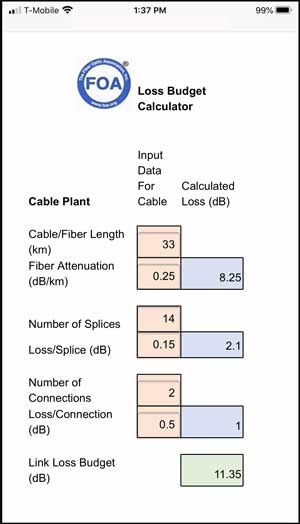
Bookmark
this page (especially on your smartphone): FOA Loss Budget Calculator
Online
|
Worth Reading
Each month we read
hundreds of newsletters and online articles. These
are the ones we think you will find "worth
reading."
FOA has a web page with resources on fiber broadband networks and the IIJA/BEAD funding programs.
Cross Reference Guide to FOA Textbooks, Online Guide and Fiber U
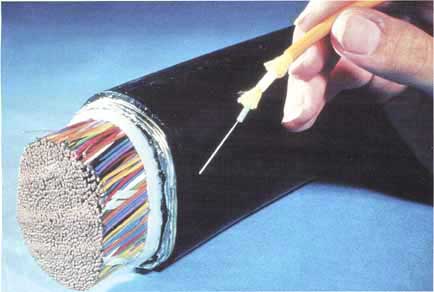 AT&T PR photo from the mid 1970s AT&T PR photo from the mid 1970s
The FOA's History
|
Worth Reading (And
Watching):
October 2023
Fiber vs Wireless - Are You Kidding? FOA's Jim Hayes in ISE Magazine Of course we need both!
WiFi can 'read' letters through walls - Futurity - Who's secure now?
Energy Dept. Pours Billions Into Power Grids but Warns It’s Not Enough - NYTimes -
America’s electric grids may need to expand by two-thirds by 2035
to handle future growth in clean energy, the agency said. The nation
isn’t on track. Also National Transmission Needs Study - US Dept. of Energy Study the NYTimes is based on.
Wildfires, Natural Disasters & Network Resilience by Next Century Cities
September 2023
TIA Fiber Optic Technology Consortium "Standards Explorer" Covers Ethernet, more coming.
Developing a Fiber Workforce Really Does Take A Village - FOA President Jim Hayes' May/June column in ISE magazine looks at the role of manufacturers' training in developing the fiber workforce.
We
need more people learning trades. Something is finally being done about
it. If you’re able to work with your hands, you’ll never be out of
work. Washington Post Editorial.
Statistics show that for every five baby boomers retiring, there’s only
one person to take their position.
Can Our Industry Develop Fiber Talent?, FOA President Jim Hayes' May/June column, ISE magazine.
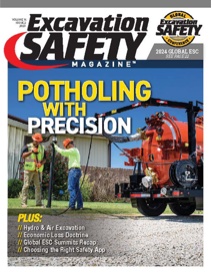
The Summer edition of Excavation Safety Magazine is online
Special For High Level Techs And Engineers:
Standards and Testing Photonic ICs
Point to Multipoint Networks at Infinera
From Past FOA Newsletters
Telegeography Submarine Cable Map 2023 - You can also buy copies - Telegeography
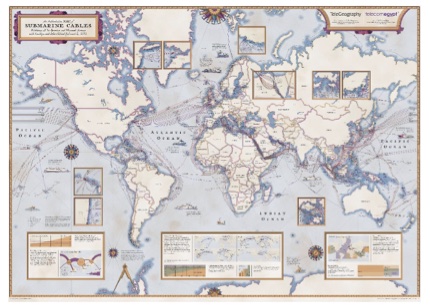
CABL® (cabl.com) serves
the business needs of the Broadband industry (including traditional
cable TV, fiber, telecom and satellite providers) with employment
listings, classified ads, discussion forums, and more. A contractor told us it's where they find lots of opportunities for subcontracting.
Do You Believe In Magic? Sufficiently advanced technology is indistinguishable from magic. Jim Hayes's column in March/April ISE Magazine.
The Secret to Future Proofing, by Jim Hayes, FOA President, ISE Magazine
The 45 Year Old Overnight Sensation - article by FOA President Jim Hayes in ISE Magazine (Read the complete Nov/Dec issue of ISE Magazine here.
Fiber
optics take the pulse of the planet It’s like radar, but with light.
Distributed acoustic sensing — DAS — picks up tremors from volcanoes,
quaking ice and deep-sea faults, as well as traffic rumbles and whale
calls. Knowable Magazine++++++
ESRI has created an ebook on GIS location technology for telecom. Use the link to download the book.
The First Transcontinental Telephone Line
began operation on July 29th in 1915 - 3400 miles between New
York and San Francisco - required over 100,000 telephone poles! Wonders
of World Engineering
Conocimiento Esencial: ¿Por qué la fibra óptica? creado por FiberWizards
Recruiting And Training Today's Fiber Optic Workforce - Learn the fundamentals to recruit and train new fiber optics - by FOA's Jim Hayes in ISE Magazine.
Explosive Fiber Broadband Expansion Drives Need for Fiber Technician Training Programs
- Telecompetitor - As fiber sees record-setting deployment levels, the
demand for fiber optic technicians is stronger than ever.
Google Video On Their Undersea Cables YouTube Slick but interesting video on how undersea cables are designed, built and used.
Construction Without Disruption - FOA President Jim Hayes' column in ISE Magazine
Fiber Optics Installed By The Lowest Bidder - ISE Magazine - by Jim Hayes, FOA President.
Building Broadband During Component and Worker Shortages
- Broadband Communities - Completing broadband builds requires
competent fiber optic techs, but training them requires understanding
how they learn - by Jim Hayes, FOA President.
Worth Reading - Magazines, Websites and Newsletters
CABL® (cabl.com) serves
the business needs of the Broadband industry (including traditional
cable TV, fiber, telecom and satellite providers) with employment
listings, classified ads, discussion forums, and more. A contractor told us it's where they find lots of opportunities for subcontracting.
New Fiber Optic
Magazine In Spanish
Todo Fibra Optica is
a new digital magazine in Spanish for fiber optics
in Latin America and South America. Jose Enriquez, editor of Todo
Fibra Optic magazine has many years
experience in the fiber optic industry so he knows
the industry well. FOA will be working with him to
share our extensive technical materials in Spanish.
Read their newsletter here. It is now available online in English and Spanish.
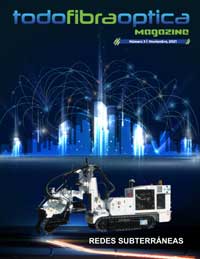
All issues and subscriptions.
Contact:
José Manuel Enriquez Mora, Editor
Todo Fibra Optica LLC
https://todofibraoptica.com/revista-ediciones/
+52 222 302 8224
jose.enriquez@todofibraoptica.com
RTI Telecom Magazine from Brazil, in Portuguese. A revista RTI do mês de abril já está disponível online e recomendo a leitura de alguns artigos:
1995-2020
- FOA's 25th Anniversary!
As
part of celebrating 25 years of serving the fiber
optic industry as its primary source of technical
information and independent certifying body, FOA
thought it appropriate to create a short history of
the organization and how it has developed to
help the fiber optic industry. We also wanted to
recognize the contributions many people have made to
the organization over the years that made FOA what
it is today.
The FOA history is now archived on the FOA
website where you can read it anytime or link to
it. Updated
info - dB, total internal reflection and science
projects,
Worth Reading - News
Summary & History - More Past Links Worth Repeating
1983
Video of AT&T's First Test Of A Submarine
Cable System From the AT&T Tech
Channel archives (worth exploring!)
Richard
Epworth's Optical Fiber History from his work
at STL from 1966 with Charles Kao.
Communications Systems Grounding
Rules: Article 800 provides specific
requirements by
Michael
Johnston, NECA Executive Director of
Standards and Safety in EC Magazine
US Broadband Coverage By Service
Provider from the FCC
How
To Build Rural Broadband, Learning From History
In the August 2021
FOA Newsletter, we published a lengthy article on
rural broadband and compared it to rural
electrification in America in the last century.
Much of the comparison was based on an article
written in 1940 by a USDA economist, Robert Beall,
called "Rural Electrification."
If
you are interested in or involved in rural
broadband, we recommend you read the article "How
To Build Rural Broadband, Learning From History"
in the August 2021 FOA Newsletter and
read the Beall article also.
Recycling Fiber Optic
Cable - Contact:
Steve Maginnis
LD4Recycle/ CommuniCom Recycling
(Visit
website)
sm@LD4Recycle.com
803.371.5436
Sumitomo's Ribbon
Splicing Guide - download from
one of the leaders in splicing.
"Who Lost Lucent?: The
Decline of America's Telecom Equipment Industry"
This is a MUST READ for managers in telecom or any
industry!
This long and
well-researched and annotated article in American
Affairs Journal should be mandatory reading
for every high level manager in a telecom company -
or any other company for that matter. To summarize
the article, today, America has no major telecom
equipment company and fears the major suppliers of
equipment who are all foreign, especially the Huawei
from China. This article explains how America got
into this deplorable state.
OFS also has an excellent
website and blog of tech articles worth browsing.
IEC 60050 - International
Electrotechnical Vocabulary - An
extensive dictionary for fiber optics in English and
French. Highly technical - this is one definition:
"mode - one solution of Maxwell's equations,
representing an electromagnetic field in a certain
space domain and belonging to a family of
independent solutions defined by specified boundary
conditions"
If you are interested in restoration -
aren't we all? - you should also read this
article in dpPro magazine by FOA President Jim
Hayes: Damage Protection Requires
Looking Overhead As Well As Underground
- dpPRO Magazine - about the problems with
aerial cables. His previous article for the
magazine was New Techniques for Fiber
Optic Installation. The Institute for Local
Self-Reliance weekly newsletter has
lots of interesting articles and links.
Universal access to broadband
is a cornerstone to a strong economy,
Achieving universal access will require
community partnerships. by Alfreda
B. Norman, Sr. VP, Federal Reserve Bank of
Dallas
FIBER TO THE FARM: The
co-ops that electrified Depression-era farms are
now building rural internet. Be sure to check out
the high-tech equine installation equipment.
Next Century Cities Newsletter
- News from cities around the US
including Detroit and New York plus small
Infrastructure Get Some
Respect, NY TImes "On Tech"
"The magic of the internet requires a lot of
very boring stuff behind the scenes. "
DIRT
Report On Damage To Utilities Common Ground
Alliance (CGA) annual DIRT report provides a
summary and analysis of the events submitted into
CGA’s Damage Information Reporting Tool (DIRT) for
the year 2018. The complete report is available
for download here. In addition,
there is an interactive dashboard that
allows users to filter the data more by
factors contributing to damages.
Structured Cabling News
- a website and weekly newsletter about cabling.
Fiber Trivia From
Corning.
The
Future Of Work Is Skills - So Stop Worrying
About Degrees - The
reality is the future of work is about skills, not
just degrees. (FOA Newsletter Feb 2020)
The job market is hot. So why
are half of U.S. grads missing out?
VIAVI Books On
Fiber Optic Testing (2 volumes) - They're back!
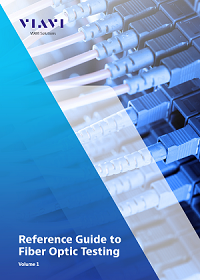 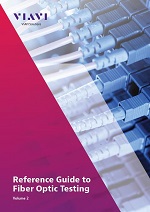
Besides
the FOA reference materials, two JDSU/VIAVI
textbooks, Reference Guide to Fiber Optic Testing,
Volumes 1 and 2, were used as references for
some of the FOA courses and are recommended for
instructors and students. The books are available
from VIAVI as eBooks and the everyone should
download them and recommend them to others.Download
yours now. Volume 1. Volume 2. Viavi Books
Ciena's Submarine Cable
Handbooks (4 to download)
Guidebook To MPO
Testing OptoTest
offers this complete guide to MTP®/MPO testing. In
this guide, you will learn all there is to know
about the different test methods, equipment
options, troubleshooting, and best maintenance
practices to ensure that you have the best testing
experience. Go here to download the book.
50th Anniversary of The
Development of Low Loss Fibers A history
of the development of low loss fiber, a fascinating
story by Jeff Hecht on the OSA (Optical Society of
America) website.
How OFS Makes Fiber
Interesting YouTube video on how fiber is made.
Perhaps a little too much "show biz" but
fascinating. If you have ever seen fiber
manufacture, look at this video. You will be amazed
at how big preforms have become!
The True Cost of Telco Damages
(what backhoe fade or target practice can
cost)
Rural Electric Cooperatives:
Pole Attachment Policies and Issues, June 2019.
Clearfield-FOA Certification
Training Clearfield is now offering
their customers an FOA
CERTIFICATION course. This course
provides a basic understanding of fiber optic
technology, as well as Clearfield product
knowledge and how Clearfield’s integrated product
systems work together in a fiber network.
Substandard Contractors - Fiber
Optic Knowledge Doesn't Always Trickle
Down (EC Mag)
|
Q&A
When readers ask us questions, we genrally refer them to FOA
resources where they can find the answer to their question and many
more. We first send them to the FOA Guide
which is the table of contents for the FOA technical resources. There
they can find pages indexed by topic and a search engine for the FOA
website. It also links them to FOA videos and courses on our free online learning site Fiber U.
The FOA
Fiber FAQs Page (FAQs = frequently asked
questions) gathers up questions readers have
asked us (which first ran in this newsletter)
and adds tech topics of general interest.
|
Good Question!
Tech
Questions/Comments From FOA Newsletter Readers
October 2023
Microtrenching
Q: What is microtrenching?
A: Microtrenching is a technique for installing underground
fiber. It is done by sawing a groove in the road or sidewalk and
dropping a small (~1/2 inch or 13mm) plastic tube (duct) into the
groove and filling it up with material like the surface so it almost
disappears. The cable is “blown” into the duct with high pressure air -
actually the air floats the cable in the duct to reduce friction and the
cable is pushed into the duct.
Here are photos of a microtrenching installation in Toronto. Here is the explanation of microtrenching in the FOA Guide section on OSP Construction (about 3/4 down the page.)
We don’t think any of our schools teach this in the US but Triple Play does in South Africa.
In the US we recommend going to one of the companies that makes the construction equipment, primarily Ditch Witch.
Previous Questions
Degraded Underground Fiber Optic Cable
Q: How can you handle a degraded buried
underground fiber link, which has degraded due to multiple joints
introduced during maintenance?
A: If it has reached a point where the loss or dispersion limits its use, it probably should be replaced.
Maintaining Fusion Splicers
Q: What are the best practices for the preventative maintenance of splicers, cleavers, and thermal strippers.
A: Because of the large number of manufacturers and variety of
models and applications, The FOA generally tells people to follow the
manufacturer’s directions for use and be especially careful about
keeping the splicer unit, cleaver and stripping tools clean, then having
it serviced regularly by the manufacturer or an authorized service
facility.
Rural FTTH
Q: What does A Rural FTTH Connection Cost?
A: That's a very complicated question, because "rural" has a lot
of meanings. Is it a small town where building a FTTH Network is easy or
remote users in Alaska? An interesting set of data was made available
this month from the US Department of Agriculture, announcing $700
million in grants and loans in the 4th round of the ReConnect Program https://lnkd.in/gFe9T4b7.
Splicing Dissimilar FIbers
Q: Recently I came across a new problem while splicing optical fiber
cable. Splicing of 2 Fujikura fibers was done but loss was
observed. Initially, we felt that it is due to splicing but upon
resplicing the loss was still the same i.e. 0.3db at the splice point.
Both the cables were checked again and observed that both cables were
from different manufacturers. My question is that if different
manufacturer's cables are spliced, will it give loss? Note: Both fibers
were Fujikura but had different IOR.
A: The difference in IOR tells the reason. The loss at the joint
between the two fibers when measured by an OTDR depends on the optical
characteristics of the fibers. A difference in the fibers IOR and
backscatter coefficient will cause the loss measurement to be affected.
In one direction it measures too high, in the other direction too low or
even shows a gain. That’s why some measwurements are called gainers. If
you measure it in the opposite direction you should see low loss or a
gain. It’s explained here in the OTDR page on the FOA Guide https://foa.org/tech/ref/testing/OTDR/OTDR.html in the section “OTDR Measurement Uncertainty.”
Testing FTTH Networks
Q: I work on FTTH projects that utilize 1x32 and 1x64 splitters that
do not have any active light on the fibers. Is there a mobile source
that can be used in the field to simulate active light through splitters
and still provide enough power to travel 20km?
A: Any 1310/1490/1550 test source should have adequate power to
test them with a regular power meter. A 64 port splitter has only
18dB+any excess loss- so 20dB or so - and any power meter can measure
that with a ~0dBm to -6dBm source.
More on testing FTTH Networks
OTDR Dead Zone
Q: What is dead zone when using OTDR?
A: The "dead zone" is the length of fiber near the OTDR that is
blanked out by the overload from the test pules. See this page on OTDRs
in the FOA Online Guide: https://foa.org/tech/ref/testing/OTDR/OTDR.html
Using A Visual fault lOcator
Q: What are the best practices for using a VFL to locate fiber faults?
A: See https://foa.org/tech/ref/testing/test/visual.html in the FOA Online Guide
Fiber Splicing Cost
Q: What is the standard of costing for fiber splicing and
terminations? Is it per core / per splice or per each cable end
irrespective of the number of cores?
A: That is a very hard question to answer, other than to say ”it
depends. ” The number of fibers is definitely a factor because each
fiber must be stripped, cleaned, cleaved and spliced then placed in the
splice tray.
It also depends on:
- Single fiber or ribbon splicing?
- Type of splice closure
- Type of cable (loose tube, ribbon, flexible ribbon, high density, armored, ADSS, etc.)
- Installation: aerial or underground
- Location: urban or rural
- Set up time (same for low fiber count cable as high fiber count cable)
Most contracts will be considering the number of
fibers but also these factors, and probably they want to price by the
number of fibers, but the price per splice will vary accordingly. We've
seen quotes in the US for prices varying over a 10X range.
FTTH Network Design Course
Q: I would like some advice on how to develop a responsive curriculum involving FTTH network design.
A: FOA has lots of free resources you can use. Fiber U
offers free online courses in FTTH and Fiber Optic Network Design that
can be used to develop your courses using blended learning - online and
classroom work blended. The courses cover all aspects of these topics
and include lesson quizzes. The Design course includes a dozen case
studies ideal for student assignment, including one on FTTH. You can
also begin with other courses like Basic FIber Optics and Outside Plant
Fiber Optics and Outside Plant Construction. The Fiber U courses draw on
material in the FOA Online Guide where you will find many other pages of useful information.
Teaching a course on FTTH and FTTH Network Design is easy using this
material. The Design labs don’t require equipment; just use the case
studies we provide and develop more of your own.
Markers Required For Underground Fiber Optic Cables?
Q: Are signs required for underground cables like fiber
optic cables? Are they required to have signage so people don’t dig them
up or damage them?
A: In the US the answer is NO. There is no Federal or State law
which requires marking anything other than hazardous liquids and gases.
It is purely a business decision or a moral decision to invest in
signs/markers to protect buried fiber. If a fiber gets cut it can
disrupt 911 service and all kinds of vital communication related to
hospitals, air traffic control, etc.
Fiber Optic Color Codes Reference Chart
Q: Has anyone made a fiber optic pocket reference chart that has cable
color orders, frequencies, or other commonly used info on it?
A: The FOA has a page on its Online Guide that covers color codes
(https://foa.org/tech/ColCodes.htm). It is the most popular page in the
FOA Guide! It works great with a smartphone.

The
word on the "Dig Once" program is getting out - FOA
is getting calls from cities asking us for
information and advice. Here are some links:
The DoT page on the administration’s Executive
Order: http://www.fhwa.dot.gov/policy/otps/exeorder.cfm
And the
one to download and hand out:
A “How To” Guide from The Global Connect Initiative:
https://share.america.gov/wp-content/uploads/2016/04/6.-GCI-Dig-Once.pdf
Is There A Standard
For Fiber Optic Installation?
Another
question we get often is "Is there a standard for
fiber optic installation." The answer is yes, but
not from the usual standards groups you might
expect. Over 20 years ago, the National Electrical
Contractors Association (NECA) asked FOA to help
create a standard for installation. That standard,
ANSI/NECA/FOA-301 has been updated three times
already and is about ready for another update.
Unlike most of those groups who charge you a fortune
for standards, FOA covers the cost so ANSI/NECA/FOA-301
is available free from FOA.
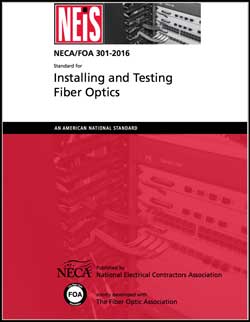
Download your free copy of ANSI/NECA/FOA-301
here (PDF)
Older
questions are now available here.
|
Training / FiberU
News and resources to help you learn more and stay
updated.
Learn about the fiber optic/ broadband workforce
Find a
listing of all the FOA-Approved schools here.

Free online
self-study programs on many fiber optics and
cabling topics are available at Fiber U, FOA's
online web-based training website.
Free online training at
Fiber U
The FOA has >100
videos on  |
The Types of Work Done By Fiber Techs And How It Affects Training

What is a fiber optic technician? What kinds of work
do they do? Those topics were the center of FOA discussions with the US
Department of Labor Bureau of Labor Statistics that led to the new job
category of "Telecommunications Technician" on the BLS
website. The focus of this job category is primarily the
installation and operation of the fiber optic cable plant, but one
should not forget the cable plant must be designed also as part of a
more extensive communications network.
In our discussion with the BLS analysts, we pointed out the various
stages of a fiber optic communications network project and how techs
with various knowledge and skill sets are needed and involved in every
step. Here is how FOA defines these stages of a project and the skills
of the techs. This is not unique to FOA; it's what has been traditional
at telecom companies forever.
Planning and Design: Once needs for a communications network is
established, project managers will be responsible for all the details of
the project while experienced fiber techs trained and experienced in
fiber optic network design (CFOS/D) will design the cable plant itself. (FOA Guide - Design)
Construction: Aerial cable plants may require installing new poles or
doing make-ready on existing poles and messengers. Underground
construction requires trenching and installation of ducts. In many cases
the actual construction is done by general construction workers, as the
construction work in many cases is not unique to fiber optics. Heavy
machinery is required for much of the construction work and training is
focused on safety as well as operating the machinery. (FOA Guide - Construction)
Fiber Optic Cable Installers: Once the route is prepared, the fiber
optic cable can be installed. Aerial cable installation depends on the
type of cable. Regular OSP cable, figure 8 cable and ADSS cable requires
special hardware and installation techniques so the techs must
understand the process appropriate for each cable. (FOA Guide - Installation)
Splicers: Since the beginning, fiber techs have been called
"splicers"
because that was the original job unique to fiber optics. Construction
and cable installation was not very different from earlier copper
cables, but splicing was very different. Even today, fiber techs are
often called splicers and splicing is a core skill for any fiber tech
whether they are joining cables or terminating them. (FOA Guide - Splicing)
Testers: After the fiber optic cable is installed and spliced,
it must be tested. Testing goes together with splicing since every
splice will be tested, often as soon as it is made so if it needs
redoing, it should be done before the splice closure is sealed. (FOA Guide - Testing)
Network Operators: Once the cable plant is built and the communications
equipment installed, it needs techs who know how to operate the comms
but may only know how to connect new gear or change connections on
current gear. These techs should also know how to troubleshoot systems
in an outage and either do the restoration themselves or call a tech who
can. (FOA Guide - Operation)
These categories merely define the stages of installation of a fiber
optic project. Of course there are subsets of these categories and most
fiber techs are expected to have skills and jobs that cross into
multiple groups, as FOA has defined in the KSAs (knowledge, skills and abilities) for a CFOT.
What an individual worker does differs according to their job. An
independent fiber contractor may cover every job except
operation and a FTTH subscriber installation tech may only understand
installing cables, testing and connecting equipment within the scope of
FTTH systems. A construction company may handle the trenching and even
pole setting as well as parts of the traditional fiber work.
The FOA defined its role early on to focus on educating and
certifying techs in the fiber specific skills: cable installation,
splicing, testing and restoration. FOA would like to see more schools
get into the construction phase, especially for newer techniques like
microtrenching and blowing cable, but these require large outdoor areas
for training and large investments in equipment. Most techs who learn
these processes now do it with OJT - on-the-job-training - and hopefully get OSHA
training for safety.
FOA School News
FOA's roster of approved schools is growing as more organizations
recognize our expertise in workforce development and our comprehensive
support for getting new schools started. FOA has over 25 years
experience and nearly 95,000 certified fiber techs (with ~130,000
certifications). As a non-profit organization founded by the industry
specifically to develop a competent workforce, FOA provides the
consultation, curriculum and contacts to get schools started as a free
service to new schools.
Complete listing of FOA Approved Training Organizations
Need A Fiber Optic Course Onsite? Invite an FOA School To Come To You
FOA often gets inquiries from an organization that
has personnel that needs training in fiber optics. Recent inquiries have
included contractors, a manufacturer of high-reliability products using
fiber optics and a cable manufacturer. In many cases, where there are
several people needing training, FOA can recommend a FOA Approved School
and Certified Instructor who will come to their location to teach a
class. The advantage is of course the savings in travel costs if
the class comes to you, but it also offers the opportunity to customize
the course to fit your needs, even use your equipment or work on your
components, so the training is more relevant to those taking the class.
Contact FOA to discuss the idea of a custom, on-site class to see if it will better meet your needs.
Fiber U
On-The-Job Training (OJT) Program
The
FOA Fiber U OJT program for novices combines online study at
Fiber U with OJT with mentoring by experienced
co-workers and their supervisor to help new employees
develop into FOA-certified technicians in only
one year.
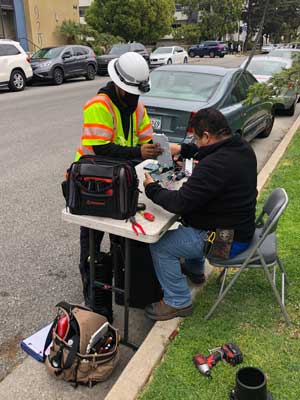
The FOA Fiber U “OJT-To-Cert”
program includes both fiber optics
and premises cabling (copper, fiber & wireless),
so it covers techs working in both outside plant and
premises jobs.
Like other FOA
programs, the OJT-To-Cert program is free. If you
and/or your company is interested in the FOA
OJT-To-Cert program,
contact FOA.
To explain how OJT
works and FOA's OJT-To-Cert program, FOA created a
short video: Lecture 62: On
The Job Training For Fiber Optics Using Fiber
U
FOA
Direct Certification Program For Experienced Fiber Optic Techs
Experience Plus
Online Study At Fiber U = FOA Certification
Experienced fiber optic technicians can become FOA Certified using
their experience in fiber optics and study for the
FOA certification exams online at Fiber U. Thousands of
industry professionals have applied to the FOA
directly for certification without the need for
classroom training, based on their knowledge and
skills developed working the field. Since FOA
certifications are based on KSAs (knowledge, skills
and abilities), current techs can show the
skills and abilities required through their field
experience. FOA provides free online self-study courses at Fiber U for the knowledge
part to prepare you for FOA certification exams
which you can also take online.
If you are an experienced field tech interested in
certification, and FOA is the internationally
recognized certifying body for fiber optics, you can
find out more about the FOA Direct Certification Program
here.
If you are already a CFOT, FOA also offers many
specialist certifications you can obtain based on
your experience as a field tech. See what's
available at Fiber
U.

Fiber U "Basic Fiber
Optics" Online Self-Study Course Now In Spanish
El curso de
autoaprendizaje en línea "Fibra óptica básica" de
Fiber U ahora en español
El sitio de
aprendizaje en línea de FOA, Fiber U, tiene más de
dos docenas de cursos de autoaprendizaje gratuitos
sobre fibra óptica y cableado de instalaciones.
Como era de esperar, el tema más popular es el
curso "Fibra óptica básica", que se utiliza para
iniciarse en la fibra óptica y como curso de
preparación para realizar el examen de
certificación FOA CFOT.
Ahora el curso básico
de fibra óptica está disponible en español,
utilizando el libro de texto FOA en español, la
sección de la Guía en línea en español y la
capacidad de YouTube para traducir subtítulos de
video al español. El curso funciona exactamente
como la versión en inglés con 10 lecciones, cada
una con cuestionarios y una opción para tomar un
examen de Certificado de finalización.
Para presentar el nuevo curso de
español Fiber U, el examen Certificate of
Completion es gratuito, así que dígaselo a sus
contactos.
Curso Básico de Fibra Óptica
de Fibra U en español.
New Fiber U Course: Fiber Characterization
FOA has added a new course at Fiber U on Fiber Characterization. Fiber
characterization is the process for testing long fiber cable plants for
its ability for carrying high speed communications. With so many
networks now operating at 100, 200, 400 or even 800 Gb/s, fiber
characterization is important, especially on older fiber optic cable
plants.The free Fiber U Fiber Characterization course is available in two forms, as a standalone Fiber U fiber Characterization Course with its own Fiber U Certificate of Completion and as a separate Lesson in the Fiber U Fiber Optic Testing course. This course is recommended for those studying for the FOA CFOS/FC Fiber Characterization certification.
Fiber U MiniCourses: Got An Hour Or Less?
Learn Something New About Fiber Optics.
FOA
has introduced a new type of Fiber U
course, the MiniCourse, a free online course you
could take in a short time, perhaps as you ate lunch
at your desk or took a coffee break. The
topics of these courses should explain what they are
about, and these are all very important topics to
fiber optic techs.
New Fiber U MiniCourse - Fiber Optic Jargon
There is a new MiniCourse at Fiber U - Fiber Optic Jargon.
Jargon is the most important thing you need to learn when you learn
about a new technology. This short Fiber U MiniCourse is intended to
introduce you to fiber optic jargon and make learning about fiber much
easier. It's aimed at novices but is a good refresher for even
experienced techs.
Fiber Optics In Communications
Fiber Optic Jargon
How Optical Fiber Works
Fiber Optic Network
Restoration
Fiber
Optic Connector Identification
Fiber U Color Codes
The Mysterious
dB of Fiber Optics
Fiber Optic Cable Bend Radius
Fiber Optic Link Loss And Power
Budgets
Fiber Optic Connector
Inspection And Cleaning
Fiber Optic Media Conversion
Fiber Optic Cable Midspan Access
Reading An OTDR Trace
Reference Cables For Testing
Fiber Optic Attenuators
The courses have two components, video lectures and
readings, that are complementary. As usual there is
a self-test to allow you to check your
comprehension. As with other Fiber U courses if you
desire, you can take a short test for a Fiber U
Certificate of Completion that costs
only $10.
All these free courses and many more
are available at Fiber U.
What Fiber Techs
Don't Know -
What We Learn From
FOA Certification Tests
As
FOA moves more testing over to our digital online
testing system at ClassMarker, we have access to
more data about our testing, including what
questions and topics on the tests are answered
incorrectly most often. Having this data gives us an
opportunity to evaluate the questions and how they
are stated, but more importantly it allow us to help
our instructors teach the subjects and us to change
our curriculum and online courses to emphasize these
particular topics. These are some of the topics that
we have noticed are answered incorrectly more often
in FOA and Fiber U tests.
Most of the questions missed are on testing.
1. OTDRs - particularly what information is in the
OTDR trace.
2. The difference between dB and dBm
3. Loss budgets - both the concepts and doing the
math
4. Insertion loss testing - single-ended or double
ended for testing patchcords or cable plants, how to
set 0dB references
5. Units of measure - fiber is measured in microns,
wavelengths in nanometers, etc.
At FOA, we're working to add Fiber
U MiniCourses on these topics and working with
our schools to emphasize these topics in their
classes.
If you are going to be taking a FOA certification
course or test in the near future, these topics
should be on your final exam study list.
What We Learn From Hands On Labs
We learn about students performance in hands-on labs
from the feedback of our instructors and our own
experiences too. One big problem is the use of hand
tools. Growing up today, you learn how to use
keyboards, mouses and touch screens, but decades
ago, you also learned how to use basic hand tools.
This is big enough of a problem that we're
considering adding some video lessons on basic hand
tools to prepare students for cable prep,
termination and splicing that require the use of
hand tools.

FOA offers free online self-study programs at Fiber U.
Many users are preparing for FOA certification
programs - taking courses at our schools or using
the Direct Certification program. Some of our
schools are requiring Fiber U programs as
prerequisites for their classroom courses so they
can spend more time on hands-on activities.
|
Publications /
Resources

|
Cross Reference To FOA Tech Materials
FOA has so much technical reference material, we created a cross reference guide to the textbooks,
Online Guide and Fiber U courses, all the FOA technical information.
Besides the textbooks, online Guide and Fiber U, each section of the
Guide also includes links to the 100+ FOA videos available.
Cross Reference Guide to Textbooks, Online Guide and Fiber U
FOA Guide To Fiber Optic Workforce Development
To help those new to fiber optic workforce development, FOA has created a web page we call "Fiber Optic Workforce Development."
In this page, we share what we have learned about the fiber optic
workforce, who they are and how they learn their trade. We discuss what
defines a fiber optic tech and how they should be certified.
Read the FOA Guide To Fiber Optic Workforce Development online.
Latest FOA Book: Fiber Broadband (Paperback and Kindle)
 In less than half a century,
fiber optics has revolutionized communications and to a large extent,
society in general. Broadband, what many today call high speed Internet
access, has become a necessity for everyone, not a luxury. The
technology that makes broadband possible is fiber optics, connecting the
continents, cities, and just about everybody. Even fiber to the home
(FTTH) brings broadband to hundreds of millions worldwide. In less than half a century,
fiber optics has revolutionized communications and to a large extent,
society in general. Broadband, what many today call high speed Internet
access, has become a necessity for everyone, not a luxury. The
technology that makes broadband possible is fiber optics, connecting the
continents, cities, and just about everybody. Even fiber to the home
(FTTH) brings broadband to hundreds of millions worldwide.
How did we get from an era when communications was making a telephone
call or sending a telegram to today’s world where every piece of
information – and misinformation – is available at the click of a mouse
or touch on a screen? How did we get from a time when a phone was
connected on copper wires to being able to connect practically anywhere
on a handheld device with more computing power than was available to
scientists and engineers only decades ago?
How does broadband work? Without fiber optics it would not work.
This book is not the typical FOA technical textbook - it is written for
anyone who wants to understand fiber broadband or fiber optics or the
Internet. It's also aimed at STEM teachers who want to include
communications technology in their classes. This book will try to
explain not only how fiber broadband works, but how
it was developed. It is intended to be an introduction to
communications technology
appropriate for a communications course at almost any level (junior
high, high school or
college,) for managers involved with broadband projects, or for anyone
who just wonders how all this stuff works.
The Fiber Optic Association Guide To Fiber Broadband
Paperback ($12.95) and Kindle ($9.95) versions available from Amazon or most booksellers. Kindle version is in color!
More Translations of FOA Textbooks
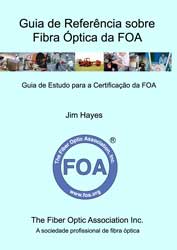 FOA is a very international organization and it works hard to
accommodate the language needs of everyone. We have been translating our
books and website into the languages most requested, and this month, we
add two more textbook translations. We also want to thank Jerry Morla,
FOA CFOS/I instructor and Director who has been doing the recent
translations into Spanish, his native language. FOA is a very international organization and it works hard to
accommodate the language needs of everyone. We have been translating our
books and website into the languages most requested, and this month, we
add two more textbook translations. We also want to thank Jerry Morla,
FOA CFOS/I instructor and Director who has been doing the recent
translations into Spanish, his native language.
Here is a listing of all the FOA textbook Translations
Spanish Editions:
Guía de Referencia de la Asociación de Fibra Óptica (FOA) Sobre Fibra
Óptica: Guía de estudio para la certificación de la FOA Amazon
La Referencia de Cableado para Predios de la FOA: Guía para Certificación de la FOA Amazon
La Asociación de Fibra Óptica Manual de Fibra Hasta el Hogar : Para
Planificadores, Gestores, Diseñadores, Instaladores y Operadores De
FTTH Amazon
Guía de Referencia de la FOA sobre Diseño de la red de fibra óptica: Guía de Estudio para la Certificación de la FOA Amazon
And the FOA Reference Guide To Fiber Optics:
French Edition: Le
Guide de référence de la FOA pour la fibre optique et et
guide d'étude pour la certification FOA: Guide d'étude pour
la certification FOA Amazon
Portuguese Edition: Guia de Referência sobre Fibra Óptica da FOA : Guia de Estudo para a Certificação da FOA Amazon
The subject matter of these books is also translated in the FOA Guide online.
Planning A Fiber Optic Project?
The FOA Guide To Fiber Optic Projects includes this timeline and comments on project planning and implementation.
More New FOA Video
Lectures On YouTube
Did you know YouTube
will close caption videos in many languages?
Here are directions.
FOA Lecture 73, The History of Fiber Optics - A Timeline fiber optics from the beginning.
FOA YouTube Video Describes
On-The-Job Training (OJT)
FOA Lecture 67 Fiber Optics At
Electrical Utilities
More New Videos
Including FTTH Series
Like all our YouTube lectures, they are
all short and easy to understand.
Did
you know YouTube will close caption videos in many
languages?
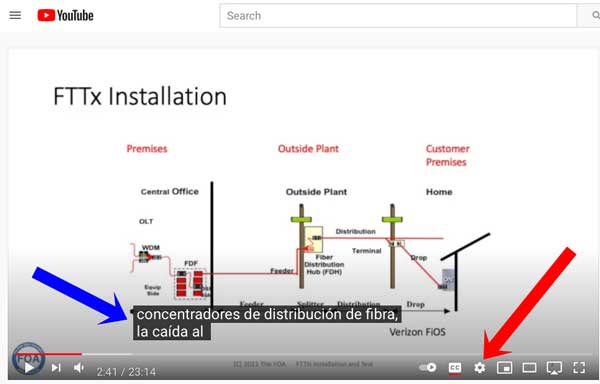
Sign in with Google to get translations for closed
captioning. Click on the settings icon (red arrow.)
Choose "Subtitles". English is the default
language. Click on the arrow after "English
(auto-generated) >". In the new window click on
"Auto-translate" and choose the language you
want.
FOA Loss Budget
Calculator On A Web Page 5/2020
FOA
has written many articles about loss budgets,
something everyone involved in fiber optics needs to
know and needs to know how to calculate. We recently
discovered how to get a spreadsheet ported to a Web
page, so we created this web page that calculates
loss budgets. We have an iOS loss budget app, but
with this web page, you can calculate loss budgets
from any device, smart phone, tablet, laptop, or
desktop computer that has web browsing capability.

Bookmark this page (especially on your
smartphone): FOA Loss Budget Calculator
Online
 We are continually updating the Online Reference
Guide to keep up with changes in the industry and
adding lots of new pages of technical information.
When you go to the FOA
Guide Table of Contents to see the latest
updates - look for
We are continually updating the Online Reference
Guide to keep up with changes in the industry and
adding lots of new pages of technical information.
When you go to the FOA
Guide Table of Contents to see the latest
updates - look for  . .
Recent updates:
FTTH
Updates: Added a section on FTTH Network Design,
updated Architecture and PONs (10G)
Color Codes For Fiber Optics
Includes print your own pocket guide and versions for your smartphone.
Fiber
Optic Projects - the FOA Guide to projects from
concept to operation
Coherent Communications Systems in
the FOA Guide.
Go
to The FOA Online Fiber Optic
Reference Guide.
FOA Reference Books
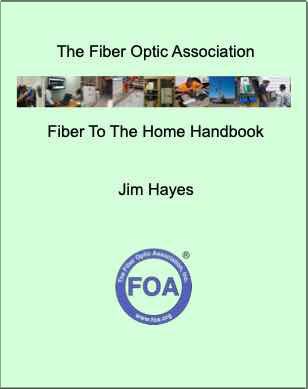
FOA's FTTH Handbook: We've
gathered all our information on FTTH from the FOA
Guide and past issues of the FOA Newsletter and
edited it into a 112 page "FTTH Handbook." We even
added a section on planning and managing FTTH
Projects.
The Fiber Optic Association
Fiber To The Home Handbook is
available from Amazon in print and Kindle
editions.
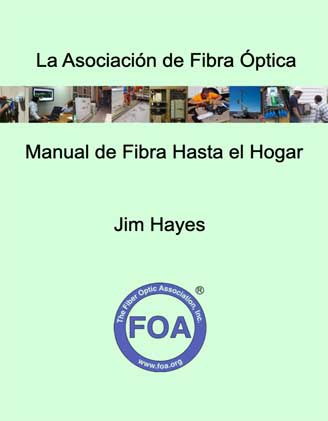
Sitio web y manual de FTTH ahora en español
Sitio web y manual de FTTH ahora en español - FTTH Website And Handbook Now In Spanish
El Manual FOA FTTH se ha convertido en el libro FOA
más vendido y tiene una calificación de 4.7/5 por parte de los
compradores en Amazon.
FOA ha notado mucho interés en FTTH en otras áreas del mundo,
especialmente en América Central y del Sur, por lo que tradujimos el
sitio web de FTTH y el Manual de FTTH al español.
Available in paperback from Amazon or ebook on Amazon Kindle.
Disponible como libro de tapa blanda en Amazon o como libro electrónico en Amazon Kindle.
El sitio web de FOA FTTH ahora en español.
El Manual FOA FTTH se ha convertido en el libro FOA
más vendido y tiene una calificación de 4.7/5 por parte de los
compradores en Amazon.
FOA ha notado mucho interés en FTTH en otras áreas del mundo,
especialmente en América Central y del Sur, por lo que tradujimos el
sitio web de FTTH y el Manual de FTTH al español.
Disponible como libro de tapa blanda en Amazon o como libro electrónico en Amazon Kindle.
El sitio web de FOA FTTH ahora en español.
 
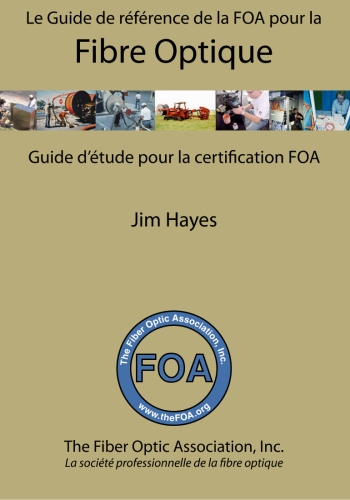      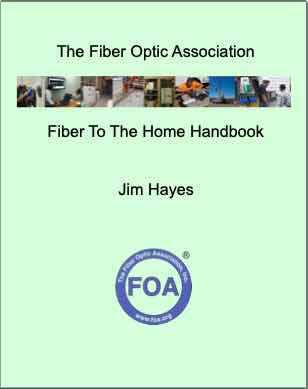
Fiber Optics (4 languages), Premises Cabling, OSP
fiber and construction, Network Design, Testing and
FTTH
The FOA has it's own
reference books for everyone working in fiber
optics - contractors, installers and end users as
well as for use as textbooks in classes at
educational institutions. They are available as
printed books or Kindle at much lower prices than
most textbooks since we self-publish and sell
online, cutting out the middlemen. Click on the
book images for more information. The Reference
Guide To Fiber Optics is also available in
Spanish, French and Portuguese. The Design book is available in English
and Spanish.
Click on any book for more information
about it.
FOA
has reprinted

"Lennie Lightwave's Guide"
on its 25th anniversary in a special print
edition.
Lennie
and Uncle Ted's
Guides are online or as free iBooks on iTunes.


Click on any of
the books to learn more.
- Fiber
Optic Safety Poster to download and
print
Resources For
Teachers In K-12 And Technical Schools
Teachers in all grades can introduce their
students to fiber optic technology with some
simple demonstrations. FOA has created a page for
STEM or STEAM (science, technology, engineering, arts
and math) teachers with materials appropriate to
their classes. Fiber Optic Resources For
Teachers.
|
Safety
|
On Safety
The FOA is concerned about safety!
FOA
considers safety an integral part of all our
programs, curriculum materials and technical
materials. We start all our textbooks and their
online versions with a section on safety in the
first chapter, like this: Before
we get started - Safety First!
There are pages on the FOA Guide on Safety
procedures Including Eye Safety and. Digging
Safely
And a YouTube lecture: FOA Lecture 2: Safety When Working
With Fiber Optics
In our OSP Construction Section, these pages cover
many safety issues including those related to the
construction of the cable plant: Project Preparation And Guidelines,
Underground Cable Construction,
Underground Cable Installation
and Aerial Cable Installation.
There is even a safety poster for the fiber
activities: PDF Safety Rules For Fiber Optics
Other Safety Resources:
There is a toll-free
"call before you dig" number in the USA: Dial 811. See www.call811.com
for more information in the US. Here is their map of resources by states.
In Canada, it's "Click Before You Dig.com" They also have a page of resources by US states and Canadian provinces.
The Common Ground
Alliance has an excellent "Best Practices Guide"
online
- The US Department
of Transportation has a website called "National
Pipeline Mapping System" that allows one
to search for buried pipelines.
Why We Warn You To
Be Careful About Fiber Shards
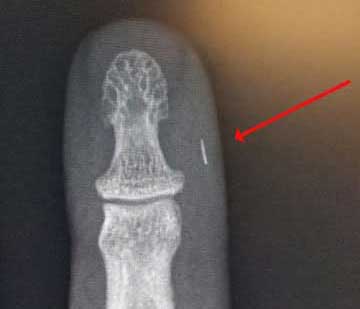
Photo courtesy Brian Brandstetter,
Mississauga Training Consultantcy
FOA
Corporate Program - Products & Services
Search
for products and services offered by hundreds of fiber optic companies worldwide.
List
of corporate information on the FOA website.
FOA Corporate Program is available to companies involved in fiber
optics as manufacturers, contractors, installers, etc. Read
more.
|
FOA/About
About The FOA
- Contact
Us: http://www.foa.org
or email <info@foa.org>

FOA has a company page
and four LinkedIn Groups
FOA
- official company page on LinkedIn
FOA
- covers FOA, technology and jobs in the fiber optic
marketplace
FOA
Fiber Optic Training - open to all, covers
fiber optic technology and training topics
Grupo de La Asociación de
Fibra Óptica FOA (Español)
|
What is The FOA?
The FOA is a, international non-profit
educational association chartered to promote
professionalism in fiber optics through education,
certification and standards.
Founded in 1995 by a dozen prominent fiber optics
trainers and leaders from education, industry and government as a professional society for fiber
optics and a source of independent certification,
the FOA has grown to now being involved in numerous
activities to educate the world about fiber optics
and certify the workers who design, build and
operate the world's fiber optic networks.
Read More
FOA History
FOA Timeline of Fiber Optics
Contact
Us
The Fiber Optic Association Inc.
https://www.foa.org or email
<info@foa.org>
https://www.thefoa.org or email <info@thefoa.org>
Telephone/text: 760-451-3655
The
FOA Home Page

Want to know more about fiber optics? Study
for FOA certifications? Free
Self-Study Programs are on "Fiber U®."
Looking for specific information? Here's the largest
technical reference on the web: The
FOA Online Fiber Optic Reference Guide.

Free online self-study programs
on many fiber optics and cabling topics are
available at Fiber U,
FOA's online web-based training website.
|
-
Contact Us
The Fiber Optic Association Inc.
The FOA Home Page
Fiber Optic Timeline
(C)1999-2023, The Fiber Optic Association, Inc.
|
FOA Logo
Merchandise
New FOA Swag! Shirts,
Caps, Stickers, Cups, etc.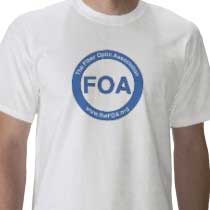
The
FOA has created a store on Zazzle.com offering lots
of new logo merchandise. It has lots of versions of
shirts and other merchandise with "FOA," "Fiber U,"
"Lennie Lightwave" designs and more so you should
find something just for you! See FOA on Zazzle.
-
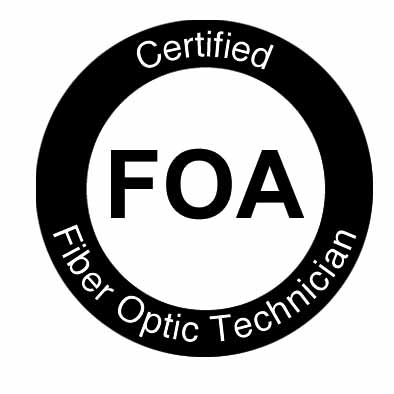
Your
Name, CFOT® - It pays to advertise!
The FOA encourages
CFOTs to use the logo on their business cards,
letterhead, truck or van, etc. and provides logo
files for that purpose. But we are also asked
about how to use the CFOT or CFOS certifications.
Easy, you can refer to yourself as "Your Name,
CFOT" or "Your Name, CFOS/T" for example.
Feel free to use the
logo and designations to promote your achievements
and professionalism!
Contact
FOA at info@thefoa.org to get logos in file format
for your use.
Privacy Policy (for
the EU GDPR): The FOA does not
use cookies or any other web tricks to gather
information on visitors to our website, nor do
we allow commercial advertising. Our website
hosts may gather traffic statistics for the
visitors to our website and our online testing
service, ClassMarker, maintains statistics of
test results. We do not release or misuse any
information on any of our members except we will
confirm FOA certifications and Fiber U
certificates of completion when requested by
appropriate persons such as employers or
personnel services.
Read
the complete FOA Privacy Policy here.
|





























 The FOA Design textbook is available in Spanish also.
The FOA Design textbook is available in Spanish also.





















 OptConn
is a value-add re-seller of optical connectivity products, services and
solutions. With over 30 years of experience in the fiber optics
industry we are here to serve your requirements from fiber optic
training with FOA certification to products, materials and supplies.
OptConn
is a value-add re-seller of optical connectivity products, services and
solutions. With over 30 years of experience in the fiber optics
industry we are here to serve your requirements from fiber optic
training with FOA certification to products, materials and supplies. 




 Then we realized that many of your also do structured cabling
work, so it was a natural to add a Color Code Guide for UTP copper
cabling in printable (below) and electronic (above) versions.
Then we realized that many of your also do structured cabling
work, so it was a natural to add a Color Code Guide for UTP copper
cabling in printable (below) and electronic (above) versions. 













 .
.





